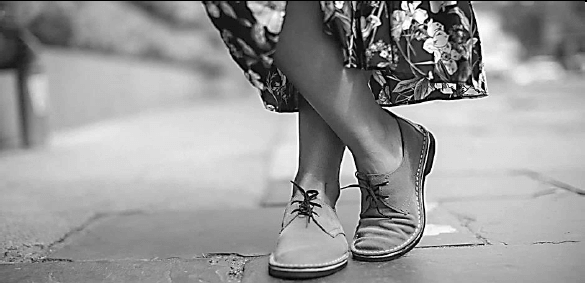Adele
English Home Language Paper 1 Questions - Grade 12 September 2021 Preparatory Exams
INSTRUCTIONS AND INFORMATION
- This question paper consists of THREE sections:
SECTION A: Comprehension (30)
SECTION B: Summary (10)
SECTION C: Language in context (30) - Read ALL the instructions carefully.
- Answer ALL the questions.
- Start EACH section on a NEW page.
- Rule off after each section.
- Number the answers correctly according to the numbering system used in this question paper.
- Leave a line after each answer.
- Pay special attention to spelling and sentence construction.
- Suggested time allocation:
SECTION A: 50 minutes
SECTION B: 30 minutes
SECTION C: 40 minutes - Write neatly and legibly.
QUESTIONS
SECTION A: COMPREHENSION
QUESTION 1: READING FOR MEANING AND UNDERSTANDING
Read TEXT A and TEXT B and answer the questions set.
TEXT A
WHY IT’S SO HARD TO FIND YOUR LIFE’S PURPOSE
by Douglas LaBier
- Over the decades I’ve heard many men and women – whether they’re psychotherapy patients working to build healthier lives or business executives trying to create healthier leadership – say that they don’t know why they’re really here, on this planet. Many turn to various books and programmes to identify their life’s purpose, but most come away dissatisfied, no closer than they were before.
- And yet, many do find and live-in harmony with their life’s purpose.
- Everyone feels a pull towards some defining purpose to his or her life, no matter how much it may have become shrouded along the way. In fact, all
forms of life have some purpose. There’s always movement or evolution towards some kind of outcome or fulfilment – whether it's a tree that produces fruit or clouds that form to produce rain. But we become so enraptured by our daily activity, engagements, goals that our awareness of our own unique life purpose is easily dimmed. - There are consequences to not finding your purpose. Often men and women who’ve become successful in their work or relationships – their outer lives – still feel hollow, unfulfilled. They describe feeling “off-track” in some way, or incomplete, despite a conventionally successful life. Sometimes they wonder if they’ve been on the “wrong” path all along –chosen the wrong career, or the wrong life partner.
- Or they haven’t realised that their chosen path could be more meaningful to them. If they let it.
- One thing is clear: The consequences of not finding your purpose include chronic, lingering dissatisfaction; an absence of inner peace and a sense of
not being fully in sync with your inner self. That's because your true inner self knows that your life purpose is out of sync with your outer life. The latter is often a false self, but you’ve identified with it because it’s been so rewarding to your ego. - Most people retain at least a glimmer of awareness of their life’s purpose within their inner being. It often feels like a leaning, an inclination, that continues to pull at you. Sometimes it is right in front of your eyes, but you don’t allow yourself to see it, like when you're hunting for your missing keys and then discover that they've been right in front of you the whole time. For example, an investment advisor found himself doing more and more work
with charity organisations. He finally realised that what he felt most in sync with was hands-on work helping people. That was the part he enjoyed about his work, not the money managing per se. Helping people was his true calling, and it was staring him in the face the whole time. - But it’s important not to confuse seeking happiness with finding your purpose. Happiness is what you experience in the daily flow of life – the highs and lows that are situational. They will fluctuate. But purpose is deeper. It’s more of an underlying sense of peace and fulfilment overall. It transcends everyday ups and downs, the disappointments or successes, even. They don’t distract you from that larger vision, your ideal, which is
like a magnet steadily pulling you towards it. - There are commonalities among those who find their true reason for being. They aren’t very preoccupied with self-interest. That sounds contradictory. But when you’re highly focused on yourself, with getting your goals or needs met – whether in your work or relationships – your purpose becomes
obscured. Letting go of self-interest opens the door to recognising your true self, so you can see whether it’s joined with your outer life and creates a sense of purpose – or clashes with it. Knowing who you are inside – your true values, secret desires, imagination; your capacity for love, empathy, generosity – all relate to and inform your life purpose. - Those who discover their life purpose also use their mental and creative energies to serve something larger than themselves. Giving your mental, emotional and creative energy comes naturally when you serve something other than your self-interest. For some, their service and sense of purpose is embodied in the work that they do every day. It’s the difference between passion in the service of creating a new product, rather than trying to capture a big market share from the product.
- Service towards something beyond ego is always visible in those who’ve found their purpose, whether younger or older. Sometimes it’s by conscious intent. For example, letting go of a previous path when they awaken to its not being in sync with their inner self.
- I find that men and women who set out to awaken to their life purpose radiate a calm inner strength, inspiration, power and success in whatever they do with their lives. It radiates to all around them.
[Adapted from: Google – huffpost.com]
AND
TEXT B
[Source: Cartoon Collections.com]
QUESTIONS: TEXT A
1.1 Refer to paragraph 1.
Account for the author’s reference to ‘decades’.(2)
1.2 List, in your own words, TWO types of people who seek to find their life’s purpose.(2)
1.3 Refer to paragraph 3.
‘Everyone feels a pull towards some defining purpose to his or her life, no matter how much it may have become shrouded along the way.’ (lines 8–10).
State, in your own words, the reason that many people consider their purpose to be obscure.(2)
1.4 Refer to paragraph 4.
Suggest a reason for the quotation marks used in “off-track” (line 17) and “wrong” (line 19).(1)
1.5 Refer to paragraph 6.
Using your own words, provide THREE possible consequences of not finding your life’s purpose. (3)
1.6 Refer to paragraph 7.
Is the following statement TRUE or FALSE? Quote to motivate your choice.Finding one’s purpose in life is always an obscure search for the unattainable. (1)
1.7 ‘If they let it.’ (line 22)
Discuss the effect of this short sentence in the context of the passage. (3)
1.8 ‘They aren’t very preoccupied with self-interest.’ (line 47)
Explain the apparent contradiction evident in this statement. (3)
1.9 The writer is of the opinion that sometimes one has to let ‘go of a previous path’ (line 64) to find one’s purpose.
Comment on the validity of this statement by referring to paragraphs 7 and 11. (3)
1.10 Refer to paragraph 8.
Explain why knowing one’s purpose ‘transcends everyday ups and downs’ (line 43) but experiencing happiness does not. (3)
QUESTIONS: TEXT B
1.11 There are two characters in this cartoon: a man with a backpack and a hermit.
Suggest a reason for the presence of the man with the backpack on the mountain top. (1)
1.12 The humour of this cartoon lies in the tone the hermit uses.
Discuss this statement. (2)
QUESTION: TEXTS A AND B
1.13 In your view, and taking paragraph 10 of TEXT A into consideration, how likely is the hermit to discover the meaning of life? Refer to TEXT A and
TEXT B in your answer. (4)
TOTAL SECTION A: 30
SECTION B: SUMMARY
QUESTION 2: SUMMARISING IN YOUR OWN WORDS.
You have been asked to research the value of perseverance. You found the following article (TEXT C) during your research on the internet. Summarise the contents of TEXT C IN YOUR OWN WORDS.
- Your summary should include SEVEN points and NOT exceed 90 words.
- Your summary must be in the form of a fluent paragraph.
- You are NOT required to include a title for the summary.
- Indicate your word count at the end of your summary.
TEXT C
PERSEVERANCE IS A MAJOR KEY TO A LIFE OF SUCCESS
Each of us thrives on being successful and in doing so we often forget the difficulties lying in the path to success. We set targets and want to achieve them right away, but we are humans and may not achieve those goals.
Failure at the start can lead to frustration, and it shatters the self-confidence you had at the beginning. You consider giving up on your dreams because you feel you can never succeed in life. The road to success is a slow and quite precarious journey at times. It takes hard work and time to build up and makes you solely responsible for your progress. However, perseverance will eventually lead you to your destination.
Perseverance is an essential element you need to achieve a high level of success. It doesn’t require any college education or training. It comes naturally. It doesn’t matter what your goal is or how long it takes you to reach that goal. The chances of your success depend largely on your willingness to persist and persevere.
Perseverance means to go on no matter what is in the way; to remain steadfast in accomplishing the difficult task. It requires a higher level of patience to develop perseverance. Someone who practises perseverance is more trustworthy than other people. People know you are not going to quit, no matter how hard the situation gets. You develop a sense of self-worth and confidence. You start taking ownership of the goals you have set to achieve. You become a firm believer that your destiny is in your hands. You control your own fate. Thus, it enhances the goal’s value for you and intensifies your motivation level. It leads you to wonderful findings and broadens your knowledge about yourself and your goals.
Perseverance. That’s the key to a successful life. If you keep persevering long enough, you will achieve your true potential. Just remember, you can do anything you set your mind to, but it takes action, persistence, and the courage to face your fears.
[Adapted from https://addicted2success.com/success-advice/perseverance-is-a-major-key-to-a-life- of-success/]
TOTAL SECTION B: 10
SECTION C: LANGUAGE STRUCTURES AND CONVENTIONS
QUESTION 3: ANALYSING ADVERTISING
Study the advertisements (TEXT D and TEXT E) below and answer the set questions.
TEXT D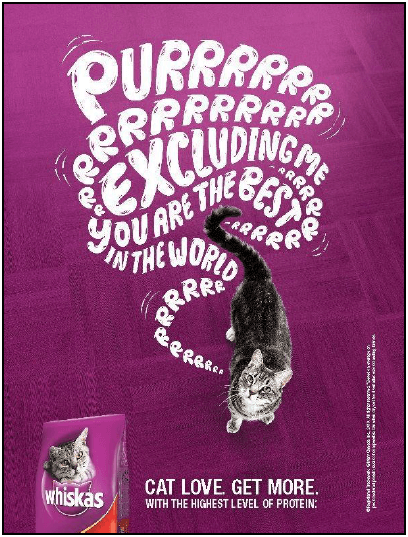
[Source: www.Pinterest.ru]
The text in the advertisement reads as follows: PURRRRRRRRRRRRRRRRRRRRRRRR Excluding me you are the best in the world. CAT LOVE. GET MORE. WITH THE HIGHEST LEVEL OF PROTEIN. |
TEXT E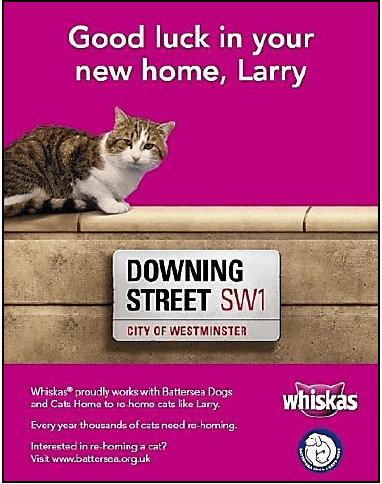
[Source: Kitty Blogger – Wordpress.com]
The text in the advertisement reads as follows: Whiskas proudly works with Battersea Dogs and Cats Home to re-home cats like Larry. Visit www.battersea.org.uk |
QUESTIONS: TEXT D
3.1 Account for the inclusion of the pack of cat food (at the bottom of the advertisement) as an advertising technique. (2)
3.2 ‘Cat love. Get more.’ Explain the double meaning implied by this slogan. (2)
QUESTION: TEXT E
3.3 ‘Good luck in your new home, Larry.’ In your opinion, is the inclusion of this sentence effective in conveying the advertiser’s message? (3)
QUESTION: TEXT D AND TEXT E
3.4 Discuss which advertisement would be more effective in reaching its target market. Refer to the text of the advertisement and to the visual in your answer. (3)
[10]
QUESTION 4: UNDERSTANDING OTHER ASPECTS OF THE MEDIA
Study TEXT F and answer the set questions.
TEXT F: CARTOON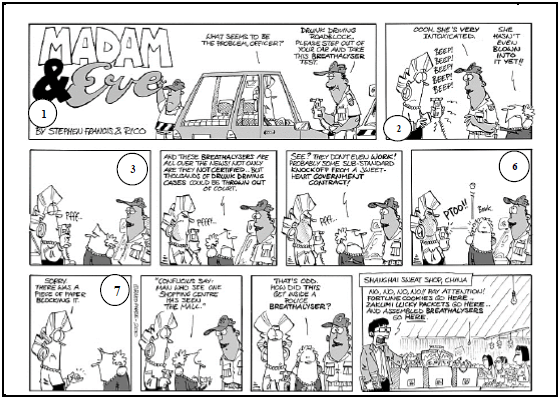
[Source: Google]
QUESTIONS: TEXT F
4.1 ‘Oooh. She’s very intoxicated.’ (FRAME 2)
Discuss how the cartoonist conveys the officer’s tone in this sentence. Refer to his words and his body language. (3)
4.2 Suggest a reason for the change in Madam’s facial expression from FRAME 3 to FRAME 6. [Madam is the person blowing into the breathalyser.] (2)
4.3 Comment on the reason for the absence of dialogue in FRAME 6. (2)
4.4 Critically discuss the cartoonist’s use of satire to convey his message. (3)
[10]
QUESTION 5: USING LANGUAGE CORRECTLY
Read TEXT G, which contains some deliberate errors, and answer the set questions.
TEXT G
RIHANNA: LIFE, CAREER, NET WORTH AND MORE
- International pop star, Rihanna, drew attention on Tuesday after she had reacted to a news report about the ongoing farmers’ protest in India. She tweeted, “Why aren’t we talking about this? #FarmersProtest.” Her tweet was widely shared on social media. If you are wondering who Rihanna is, read on.
- After performing for music producers Evan Rogers and Carl Struken in 2003, her music career started at the age of 15. Her debut album Music of the Sun was realised by Def Jam in 2005. But it was in 2007 only that the singer gained recognition with her album, Good Girl Gone Bad. Her single, Umbrella, earned Rihanna her first Grammy Award.
- Over the years, the 32-year-old singer has won many accolades, including nine Grammy Awards, 13 American Music Awards, 12 Billboard Music Awards, and six Guinness World Records. She became the first female solo artist to sell out 10 concerts at London’s O2 Arena. Since debuting, 14 No 1 hits have featured on the Billboard Hot 100 chart. Rihanna featured in the Forbes’ list of richest self-made women in 2020.
- Apart from music, Rihanna also tried her hands at acting. She made her movie debut in 2012 with Battleship. She has also been involved in philanthropic work through her non-profit organisation Clara Lionel Foundation (CLF). The singer has a strong presense on social media with over 81 million Facebook fans, 101 million Twitter followers and 90.3 million Instagram followers.
- Rihanna is also an entrepreneur and co-own cosmetic brand, Fenty Beauty.
[Adapted from Indianexpress.com]
QUESTIONS: TEXT G
5.1 Account for the use of the apostrophe in line 2. (1)
5.2 After performing for music producers Evan Rogers and Carl Struken in 2003, her music career started at the age of 15. (lines 5–6) Rewrite this sentence, changing it into a complex sentence. (1)
5.3 Identify and correct the malapropism in paragraph 2. (1)
5.4 ‘But it was in 2007 only that the singer gained recognition with her album, Good Girl Gone Bad.’ (lines 7–8) Rewrite this sentence, putting the adverb in its correct place. (1)
5.5 ‘Over the years, the 32-year-old singer has won many accolades.’ Rewrite this sentence, changing it into the passive voice. (1)
5.6 Identify and correct the unrelated participle in paragraph 3. (1)
5.7 Refer to lines 13–15. Identify and correct the incorrect preposition. (1)
5.8 ‘non-profit’ (line 18) is an example of a compound …
- adverb.
- adjective.
- verb.
- noun. (1)
5.9 Identify and correct a spelling mistake in paragraph 4. (1)
5.10 Refer to lines 18–21. Identify and correct the error of concord. (1) [10]
TOTAL SECTION C: 30
GRAND TOTAL: 70
English First Additional Language Paper 3 Memorandum - Grade 12 September 2021 Preparatory Exams
INSTRUCTIONS AND INFORMATION | ||||
This memorandum must be used in conjunction with the attached English FAL assessment rubrics for SECTIONS A, B and C. | ||||
NOTE: | All pieces of writing should be read at least TWICE during assessment, once for content and once for language respectively. Errors must be indicated in your second reading. |
| ||
SECTION A: ESSAY | ||||
QUESTION 1 | ||||
INSTRUCTIONS TO MARKERS:
| ||||
NOTE: |
|
| ||
1.1 | I will remember him/her forever |
| ||
| Narrative/Descriptive/Reflective |
| ||
|
|
| ||
| NOTE:A candidate may write an essay which contains elements of more than one type of essay/any other essay type. | [50] | ||
1.2 Then I realised …
Descriptive/Narrative/Reflective
- If descriptive, the candidate should create a picture in words using as many senses as possible to make the description clear.
- If narrative, the essay must have a strong storyline and an interesting
- If reflective, the essay should convey emotional reactions and feelings the candidate experiences/experienced.
NOTE: A candidate may write an essay which contains elements of more than one type of essay/any other essay type. [50]
1.3 Adulthood is knocking at my door.
Reflective/Descriptive/Narrative/Discursive
- If reflective the essay should convey the emotional reactions and feelings the candidate experiences/experienced.
- If descriptive, the writer should create a picture in words using as many senses as possible to make the description clear.
- If narrative, the essay must have a strong storyline and an interesting
- If discursive, the arguments for and against must be well-balanced and clearly analysed in the essay. The candidate must come to a particular conclusion at the end of the essay which should include
NOTE: A candidate may write an essay which contains elements of more than one type of essay/any other essay type. [50]
1.4 Punishment
Discursive/Reflective/Argumentative/Narrative/Descriptive
- If discursive, the arguments for and against must be well-balanced and clearly analysed in the essay. The candidate may come to a particular conclusion at the end of the essay, which should include
- If reflective the essay should convey the emotional reactions and feelings the candidate experiences/experienced.
- If argumentative, the essay must reflect a specific argument or viewpoint for or against the The candidate should give a range of arguments to support his/her view. The conclusion should be a strong, clear and convincing statement of the writer’s opinion.
- If narrative, the essay must have a strong storyline and an interesting
- If descriptive, the candidate should create a picture in words using as many senses as possible to make the description clear.
NOTE: A candidate may write an essay which contains elements of more than one type of essay/any other essay type. [50]
1.5 Can anyone be above the law?
Argumentative/Discursive/Narrative/Descriptive/Reflective
- If argumentative the essay must reflect a specific argument or viewpoint for or against the topic. The candidate should give a range of arguments to support his/her The conclusion should be a strong, clear and convincing statement of the writer’s opinion.
- If discursive, the arguments for and against should be well-balanced and clearly analysed in the essay. The candidate may come to a particular conclusion at the end of the essay, which should include
- If narrative, the essay must have a strong storyline and an interesting
- If descriptive, the candidate should create a picture in words using as many senses as possible to make the description clear.
- If reflective, the essay should convey the emotional reactions and feelings the candidate experiences/experienced.
NOTE: A candidate may write an essay which contains elements of more than one type of essay/any other essay type. [50]
1.6 “Don’t be afraid to start over [again]. It’s a chance to build something better this time.” – Anonymous
Reflective/Discursive/Narrative/Descriptive/Argumentative
- If reflective the essay should convey the emotional reactions and feelings the candidate experiences/experienced.
- If discursive, the arguments for and against must be well-balanced and clearly analysed in the essay. The candidate may come to a particular conclusion at the end of the essay, which should include
- If narrative, the essay must have a strong storyline and an interesting
- If descriptive, the candidate should create a picture in words using as many senses as possible to make the description clear.
- If argumentative, the essay must reflect a specific argument or viewpoint for or against the topic. The candidate should give a range of arguments to support his/her The conclusion should be a strong, clear and convincing statement of the writer’s opinion.
NOTE:A candidate may write an essay which contains elements of more than one type of essay/any other essay type. [50]
1.7 | Interpretation of pictures |
| |
| The candidate:
|
| |
| 1.7.1 | Picture: Guitar in a field
| [50] |
| 1.7.2 | Picture: A couple in wedding outfits
| [50] |
|
| TOTAL SECTION A: | 50 |
SECTION B: LONGER TRANSACTIONAL TEXT | ||
QUESTION 2 | ||
INSTRUCTIONS TO MARKERS: | ||
| ||
NOTE:
| ||
2.1 | FORMAL LETTER |
|
| A letter of complaint
| [30] |
2.2 | INTERVIEW |
|
| A conversation between candidate and fashion designer (former learner) |
|
|
| [30] |
2.3 | OBITUARY |
|
| A disabled friend has passed away
| [30] |
2.4 | MAGAZINE ARTICLE |
|
| Gender-based violence
| [30] |
| TOTAL SECTION B: | 30 |
SECTION C: SHORTER TRANSACTIONAL TEXT | |||
QUESTION 3 | |||
INSTRUCTIONS TO MARKERS:
| |||
NOTE: |
|
| |
3.1 | DIARY ENTRIES |
| |
The candidate’s feelings BEFORE and AFTER travelling by air.
The language may be formal or informal, but slang or colloquialism is not allowed. | |||
3.2 | ADVERTISEMENT |
| |
| Organisation of a market day
NOTE: No marks are awarded for drawings or illustrations. | [20] | |
3.3 | DIRECTIONS |
|
| Directions from the entry point to the candidates’ school
NOTE: No marks are awarded for drawings or illustrations. | [20] |
| TOTAL SECTION C: | 20 |
| GRAND TOTAL: | 100 |
SECTION A: RUBRIC FOR ASSESSING ESSAY – ADDITIONAL LANGUAGE [50 MARKS]
- Always use the rubric when marking the creative essay (Paper 3, SECTION A).
- The marks from 0–50 have been divided into 5 major level descriptors.
- In the Content, Language and Style criteria, each of the five level descriptors is divided into an upper and a lower level sub-category with the applicable mark range and descriptors.
- Structure is not affected by the upper level and lower level division.
Criteria |
| Exceptional | Skilful | Moderate | Elementary | Inadequate |
CONTENT AND PLANNING (Response and ideas) Organisation of ideas for planning Awareness of purpose, audience and context 30 MARKS | Upper level | 28–30 | 22–24 | 16–18 | 10–12 | 4–6 |
|
|
|
|
| ||
Lower level | 25–27 | 19–21 | 13–15 | 7–9 | 0–3 | |
|
|
|
|
| ||
LANGUAGE, STYLE AND EDITING Tone, register, style, vocabulary appropriate to purpose/effect and context Word choice Language use and conventions, punctuation, grammar, spelling 15 MARKS | Upper level | 14–15 | 11–12 | 8–9 | 5–6 | 0–3 |
|
|
|
|
| ||
Lower level | 13 | 10 | 7 | 4 | ||
|
|
|
| |||
STRUCTURE Features of text Paragraph development and sentence construction 5 MARKS |
| 5 | 4 | 3 | 2 | 0–1 |
|
|
|
|
| ||
MARKS RANGE |
| 40–50 | 30–39 | 20–29 | 10–19 | 0–9 |
SECTION B: ASSESSMENT RUBRIC FOR LONGER TRANSACTIONAL TEXT – ADDITIONAL LANGUAGE [30 marks]
Criteria | Exceptional | Skilful | Moderate | Elementary | Inadequate |
|
CONTENT PLANNING AND FORMAT (Response and ideas ) Organisation of ideas for planning Purpose, audience and features/conventions and context
18 MARKS | 15–18 | 11–14 | 8–10 | 5–7 | 0-–4 |
|
|
|
|
|
|
| |
LANGUAGE, STYLE AND EDITING Tone, register, style, purpose/effect, audience and context Language use and conventions. Word choice Punctuation, spelling | 10–12 | 8–9 | 6–7 | 4–5 | 0–3 |
|
|
|
|
|
|
| |
12 MARKS |
|
| ||||
MARKS RANGE | 25–30 | 19–23 | 14–17 | 9–12 | 0–7 |
|
SECTION C: ASSESSMENT RUBRIC FOR SHORTER TRANSACTIONAL TEXT – ADDITIONAL LANGUAGE [20 marks]
Criteria | Exceptional | Skilful | Moderate | Elementary | Inadequate |
|
| 10–12 | 8–9 | 6–7 | 4–5 | 0–3 |
|
CONTENT PLANNING AND FORMAT (Response and ideas) Organisation of ideas for planning Purpose, audience and features/conventions and context
12 MARKS |
|
|
|
|
|
|
LANGUAGE, STYLE AND EDITING Tone, register, style, purpose/effect, audience and context Language use and conventions. Word choice Punctuation, spelling 8 MARKS | 7–8 | 5–6 | 4 | 3 | 0–2 |
|
|
|
|
|
|
| |
MARKS RANGE | 17–20 | 13–15 | 10–11 | 7–8 | 0–5 |
|
English First Additional Language Paper 3 Questions - Grade 12 September 2021 Preparatory Exams
INSTRUCTIONS AND INFORMATION
- This question paper consists of THREE sections:
SECTION A: Essay (50)
SECTION B: Longer Transactional Text (30)
SECTION C: Shorter Transactional Text (20) - Answer ONE question from EACH section.
- Write in the language in which you are being assessed.
- Start EACH section on a NEW page.
- You must plan (e.g. using a mind map/diagram/flow chart/key words etc.), edit and proofread your work. The plan must appear BEFORE each text.
- All planning must be clearly indicated as such. It is advisable to draw a line through all planning.
- You are strongly advised to spend approximately:
- 80 minutes on SECTION A
- 40 minutes on SECTION B
- 30 minutes on SECTION C
- Number the answers correctly according to the numbering system used in this question paper.
- Give each response a suitable title/heading where required.
- Do NOT consider the title/heading when doing a word count.
- Write neatly and legibly.
QUESTIONS
SECTION A: ESSAY
QUESTION 1
- Write an essay of between 250 and 300 words in length on ONE of the following topics.
- Write down the NUMBER and TITLE of the essay you have chosen correctly, for example 1.1 I will remember him/her forever.
- Give your ESSAY a suitable title if your choice is QUESTION 1.7.1 OR 1.7.2.
- Spend approximately 80 minutes on this section.
1.1 I will remember him/her forever. [50]
1.2 Then I realised … [50]
1.3 Adulthood is knocking at my door. [50]
1.4 Punishment [50]
1.5 Can anyone be above the law? [50]
1.6 “Don’t be afraid to start over [again]. It’s a chance to build something better this time.” – Anonymous
[50]
1.7 Choose ONE of the following pictures and write an essay on a topic that comes to mind. Write the question number (1.7.1 OR 1.7.2) and give your essay a suitable title.
NOTE: There must be a clear link between your essay and the picture you have chosen.
1.7.1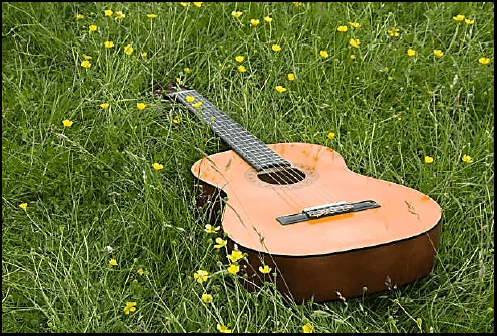
[Source: googlepictures.com] [50]
OR
1.7.2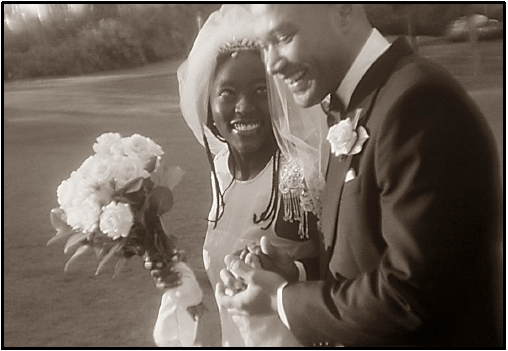
[Source: //www.countryliving.com] [50]
TOTAL SECTION A: 50
SECTION B: LONGER TRANSACTIONAL TEXT
QUESTION 2
- Respond to ONE of the following longer transactional writing texts.
- The body of your response should be between 120 and 150 words in length.
- Write down the NUMBER and the HEADING of the text you have chosen, for example, 2.1 FORMAL LETTER
- Pay particular attention to format, language and register.
- Spend approximately 40 minutes on this section.
2.1 FORMAL LETTER
You recently bought a very expensive pair of shoes from a popular shop. You found the shoes to be faulty. Then you returned them for an exchange or refund. The shop assistant refused to do the exchange or refund you.
Write a letter to the manager in which you complain about the shoes and the unfair treatment by the shop assistant. [30]
2.2 INTERVIEW
A famous fashion designer who is a former learner from your school is visiting your hometown/town. You have been asked to interview him/her. The interview will be published in your local newspaper.
Write out the interview.
NOTE: Use the dialogue format. [30]
2.3 OBITUARY
A disabled person whom you had befriended has passed away suddenly. Your friend was very special to people. You have been asked to write an obituary in his/her honour. You must also pay tribute to him/her.
Write the obituary. [30]
2.4 MAGAZINE ARTICLE
Gender-based violence has become a huge problem in our society. Many people are silent victims, especially women and children.
Write an article in which you give advice to readers on how to break the silence and how to protect potential victims from the curse of gender-based violence.
[30]
TOTAL SECTION B: 30
SECTION C: SHORTER TRANSACTIONAL TEXT
QUESTION 3
- Choose ONE of the following topics and write a shorter transactional text.
- The body of your response should be between 80 and 100 words in length.
- Write down the NUMBER and the HEADING of the text you have chosen, for example, 3.1 DIARY ENTRIES
- Spend approximately 30 minutes on this section.
3.1 DIARY ENTRIES
Recently you visited a favourite family member living in a city far away from you. You had to travel by air, and it was your first flight which was two hours long.
Write TWO diary entries. The first entry must indicate how you felt BEFORE you boarded the aeroplane and the second entry must indicate how you felt AFTER the aeroplane landed. [20]
3.2 ADVERTISEMENT
You belong to an organisation that is passionate about developing small business skills. The organisation plans to have a market day in your community.
Design the advertisement that will be placed in your local newspaper for the event.
NOTE: No marks are awarded for drawings or illustrations. [20]
3.3 DIRECTIONS
Your school has decided to celebrate the achievements of learners in sports. As a member of the planning committee, you have to give directions to invited guests attending this event.
Write the directions that guests will follow from the entry to your town and to your school.
You must include landmarks, distances and specific directions in your response.
NOTE: No marks are awarded for drawings or illustrations. [20]
TOTAL SECTION C: 20
GRAND TOTAL: 100
English First Additional Language Paper 2 Memorandum - Grade 12 September 2021 Preparatory Exams
INSTRUCTIONS AND INFORMATION
- Candidates are required to answer questions from TWO sections.
- These marking guidelines are merely a guide to assess learners’ responses.
- Candidates' responses should be assessed as objectively as possible.
- MARKING GUIDELINES
4.1 A candidate may not answer more than ONE question on the same genre.
4.2 If a candidate gives two answers where the first one is wrong and the next one is correct, mark the first answer and ignore the next.
4.3 If answers are incorrectly numbered, mark according to the marking guidelines.
4.4 If a spelling error affects the meaning, mark incorrect. If it does not affect the meaning, mark correct.
4.5 If the candidate does not use inverted commas when asked to quote, do not penalise.
4.6 For open-ended questions, no marks should be awarded for YES/NO or I AGREE/I DISAGREE. The reason/substantiation/ motivation is what should be considered.
4.7 No marks should be awarded for TRUE/FALSE or FACT/OPINION. The reason/substantiation/motivation is what should be considered.
MEMORANDUM
SECTION A: NOVEL
NOTE: Candidates are required to answer ONE question on the novel they have studied.
QUESTION 1: CRY, THE BELOVED COUNTRY
Candidates are required to answer BOTH questions, i.e. QUESTIONS 1.1 and 1.2.
1.1
1.1.1
- E / St. Marks’ parson
- C / White farmer
- B / Absalom’s lawyer
- A / Political activist (4)
1.1.2 The letter brings sad news of Kumalo’s sick sister (Gertrude). Kumalo has to take a quick decision to save his sister / to go to Johannesburg. (2)
1.1.3 She wants Kumalo to hear from the child that she has eaten. She wants to give Kumalo time to think about a possible solution. (2)
1.1.4 Kumalo is a respected member in the community as a priest. / His house is important. It has more furniture in it than what she is used to. / There are more books than what they have at school. She is showing some respect. (2)
NOTE: Accept any TWO of the above or any other relevant responses.
1.1.5
- Despair/despondency/hopelessness (1)
- He feels despondent because his son will never go to St Chad’s. (1)
1.1.6 She is patient/obedient/supportive. (1) She can see that her husband is in distress and insists on him taking a decision / or an action. (1)
1.1.7 Open-ended.
Accept a relevant response which shows an understanding of the following viewpoints, among others:
Yes.
- Mrs Kumalo is a priest’s wife and is expected to be obedient.
- Her role is to be more supportive to her husband’s decision.
- She knew that their son will not go to St Chad but she had to keep quiet.
- The money that has been saved to buy her a stove is used for Kumalo’s journey.
- Kumalo brings back Gertrude’s son and their son’s wife without her consent or knowledge.
- She does not mourn her son’s death but she has to be stoical.
No.
- Mrs Kumalo is a pillar of strength to her husband because of her patience.
- Her husband involves her in taking the decision to leave for Johannesburg.
- She loves her family and is prepared to sacrifice.
- She insists on her husband’s use of their savings to help the family.
For full marks, the response must be well substantiated. A candidate can score 1 or 2 marks for a response which is not well-substantiated. The candidate’s interpretation must be grounded in the novel. (3)
AND
1.2
1.2.1 B / respectful (1)
1.2.2 Napoleon is brought to Ndotsheni as a demonstrator by Jarvis. (1)
1.2.3 Kumalo knows Jarvis as the white man / farmer from the valley above Ndotsheni. Absalom (his son) has killed Arthur Jarvis, James Jarvis son. (2)
1.2.4 To show that he has the necessary educational qualification. So that Kumalo can know that he is the right person for the job. (2)
1.2.5
- He is excited / ecstatic. (1)
- Metaphor (1)
- The figure of speech is relevant because Kumalo’s joy.
(when he hears that the young man has come to teach farming to Ndotsheni people) is written all over his face as his eyes shine. (2)
1.2.6 He teaches them modern farming methods, to help them care for the land. (2)
1.2.7 The discussion of the theme of redemption should include the following points, among others:
- Both Kumalo and his wife have suffered so much.
- Kumalo’s son has murdered James Jarvis’s son.
- Kumalo loses his family and Jarvis loses his wife.
- Both Kumalo and James try their best to find meaning in their suffering and create something good out of it.
- They work together for the restoration of Ndotsheni.
- The work makes them treat each other with respect and kindness.
NOTE: For full marks, the response must be well substantiated. A candidate can score 1 or 2 marks for a response which is not well-substantiated. The candidate’s interpretation must be grounded in the novel. (3)
1.2.8 Open-ended.
Accept any relevant response which shows understanding of the following viewpoints, among others:
Yes.
- James Jarvis interacts with black people for the first time as equals.
- He becomes less racist and starts to take responsibility for the well- being of people who live near him.
- He supplies the community with milk for the children, builds the dam and rebuilds the church and gets them an agricultural demonstrator.
- He helps with the restoration of the people of Ndotsheni.
OR
No.
- James Jarvis is restoring what was destroyed by the white people like him.
- White people took land from black people and left them with land that is over used.
- James Jarvis has not been aware of the conditions in the country so the job was prompted by his son’s death to do something practical about it.
- The restoration is not from him but is emulating what his son Arthur was.
NOTE: Do not award a mark for YES or NO. Credit responses where a combination is given. For full marks, the response must be well-substantiated. A candidate can score 1 or 2 marks for a response which is not well substantiated. The candidate’s interpretation must be grounded in the novel. (3)
TOTAL SECTION A: 35
QUESTION 2: THE STRANGE CASE OF DR JEKYLL AND MR HYDE
Candidates are required to answer BOTH questions, i.e. QUESTIONS 2.1 AND 2.2.
2.1
2.1.1
- E / reluctant to judge
- A / has no conscience
- D / faithful and loyal
- B / much of a gentleman (4)
2.1.2 Mr Utterson is worried about Dr Jekyll after he has seen Mr Hyde. He wants to talk to Dr Jekyll about the kind of person that he is. (2)
2.1.3 Mr Hyde is the other side of Dr Jekyll. They have a mutual dependence. Dr Jekyll needs Mr Hyde for his pleasures and selfish ends. Mr Hyde needs Dr Jekyll for shelter and protection. (2)
2.1.4
- worried / concerned. (1)
- He is worried about the relationship about Dr Jekyll and Mr Hyde. He thinks Mr Hyde has evil intensions. (1)
2.1.5 A / Sad (1)
2.1.6
- Utterson is caring. He is worried that Mr Hyde does as he please at Dr Jekyll’s house.
OR
He is protective. He thinks Dr Jekyll is in trouble and he wants to help him.
NOTE: Accept any ONE of the above combinations. (2)
2.1.7 Mr Utterson assumes that Dr Jekyll is in a danger, and the problem comes from his life when he was younger. (2)
2.1.8 Open-ended.
Accept a relevant response which shows an understanding of the following viewpoints among others:
Yes.
- Mr Utterson regards Mr Hyde as a criminal and has evidence to that.
- He finds it strange that Dr Jekyll can have Mr Hyde as a benefactor and is giving him everything (even his qualifications).
- Mr Utterson thinks that Mr Hyde is blackmailing Dr Jekyll.
- Mr Utterson is told that Hyde only uses the back door in Dr Jekyll’s house and does not dine in the house; that is also strange.
No.
- Dr Jekyll is an adult and has the choice to have anyone in his will.
- Mr Hyde has a key to Dr Jekyll’s house, meaning he is not trespassing.
- Workers have seen him, though he does not dine in the house.
- Dr Jekyll trusts him enough to allow him in his house.
NOTE: For full marks, the response must be well substantiated. A candidate can score 1 or 2 marks for a response which is not well-substantiated. The candidate’s interpretation must be grounded in the novel.
Do not award a mark for YES or NO. Credit responses which is well substantiated. (3)
AND
2.2
2.2.1
- At Mr Hyde’s place. / Dr Jekyll’s flats in Soho. (1)
- Utterson is called to the murder scene and he recognises the stick he gave to Dr Jekyll is a murder weapon. He leads the officer to Soho where Mr Hyde stays. (2)
2.2.2 There are a lot of wine bottles / there are plates made of silver / stylish linen / mats of high quality.
NOTE: Accept any TWO of the above. (2)
2.2.3
- Metaphor (1)
- The officer has all the evidence he needs for the possible arrest of Mr Hyde. When Mr Hyde goes to the bank it will make it easier to get him. (2)
- There is no one who can clearly describe Mr Hyde for handbills / Mr Hyde has no photographs / His family cannot be traced.
NOTE: Accept any TWO of the above. (2)
2.2.4 Part of the murder weapon/the stick was found behind the door. (1)
2.2.5 The discussion of the theme of violence, should include the following points, among others:
- Mr Hyde commits violent acts in the novel.
- He is first seen bumping into a young girl and tramples her over.
- He cruelly beats Mr Carew to death for no reason.
- He has no remorse for what he has done but realises that he could be in trouble.
- In the end he turns his violence against himself by committing suicide.
NOTE: For full marks, the response must be well substantiated. A candidate can score 1 or 2 marks for a response which is not well-substantiated. The candidate’s interpretation must be grounded in the novel. (3)
2.2.6 Open-ended.
Accept any relevant response which shows understanding of the following viewpoints, among others:
Yes.
- Dr Jekyll has had no idea that Mr Hyde can be controlling in his life.
- He finds himself changing to Mr Hyde without taking the transformation draught.
- He becomes miserable as he cannot be among his friends.
- He cannot get the original powder he uses to transform himself from Mr Hyde to Dr Jekyll.
- He cannot go to prison for the crime he committed.
OR
No.
- Dr Jekyll knew that using the transformation draught will put his life in danger.
- He continues using it because he enjoys being Mr Hyde.
- He stops taking the potion and leads a good life.
- He does not fight the temptation to take the drug and he kills an innocent man.
NOTE: Do not award a mark for YES or NO. Credit responses where a combination is given. For Full marks, the response must be well substantiated. A candidate can score 1 or 2 marks for a response which is well substantiated. The candidate’s interpretation must be grounded in the text of
the novel. (3)
[35]
TOTAL SECTION A: 35
SECTION B: DRAMA QUESTION 3: MACBETH
NOTE: Candidates are required to answer ONE question on the drama they have studied.
Candidates are required to answer BOTH questions, i.e. QUESTIONS 3.1 and 3.2.
3.1
3.1.1
- B / The Earl of Northumberland
- D / Macbeth’s amour man
- A / The Witch Goddess
- C / Thane of Five (4)
3.1.2 Macbeth has hinted that he is going to take action about Banquo, but he would not tell her what he is going to do. (2)
3.1.3 A / to speak to Macbeth when he is free (1)
3.1.4 Lady Macbeth and Macbeth have gained from killing King Duncan but they have lost everything / their happiness. (2)
3.1.5
- Metaphor (1)
- Macbeth is only partially successful being a King by killing King Duncan. The royal family like a wounded snake will recover and Macbeth will be in danger. (2)
3.1.7
- Macbeth is self-serving – he does not care about the chaos in the country as long as he gets what he wants.
OR
Macbeth is cruel – He kills all those he considers a threat to him.
NOTE: Accept any ONE of the above combinations. (2)
3.1.8 Open-ended.
Accept a relevant response which shows an understanding of the following viewpoints, among others:
Yes.
- Banquo know about the witches’ prophecy that Macbeth will be a king.
- He may be the first to suspect Macbeth from killing King Duncan.
- The witches told Banquo that he will be a father to Kings which is a threat to Macbeth.
OR
No.
- Banquo is also a victim of the witches but he stays true to his principles.
- It is only his sons that will be kings and not Banquo.
- Banquo is a loyal friend.
NOTE: Do NOT award a mark for YES or NO. Credit response where a combination is given. For full marks, the response should be well substantiated. A candidate can score 1–2 marks for a response which is not well-substantiated. The candidate’s interpretation
must be grounded in the play. (3)
AND
3.2.1
-
- Jerk the servant to his feet.
- Push him away.
- Shout at him.
- Shove him.
NOTE: Accept any TWO of the above or any other relevant responses. (2)
- Macbeth is in a state of hopelessness and anxiety.
He is taking out his frustration on the servants and anyone around him. (2)
3.2.2
- Weariness / self-pity / despair. (1)
- Macbeth regrets that his life is empty and friendless at his age. (1)
3.2.3 Macbeth is getting reports that the thanes are deserting him. (1)
3.2.4
- Macbeth thinks that there is no man that is not born of a woman, so he cannot be defeated.
- He thinks it is impossible that Birnamwood would come to his castle.
- Macbeth is a general and is not afraid of war. (2)
NOTE: Accept any TWO of the above or any other relevant responses.
3.2.5
- Lady Macbeth suffers from sadness that causes hallucinations / mental sickness. (1)
- There is no medicine to cure mental sickness. The only cure is for the patient to be sorry for what he has done.
OR
Lady Macbeth does not need the doctor’s help. She is not physically sick but is sick in the mind. (2)
3.2.6 The discussion of the theme of guilt and its consequences should include the following points, among others:
- Lady Macbeth does not feel guilty at first.
- She manages to pull off the killing of Duncan successfully.
- She did not know that the killing of Duncan would lead to a string of killings of innocent people.
- Where she earlier called for the thick night to come and protect her, she is now terrified of the dark.
- Her sleep walking shows a woman tormented by guilt.
- She bemoans the ever present smell of blood on her hands from King Duncan’s blood.
NOTE: For full marks, the response must be well-substantiated.
A candidate can score 1–2 marks for a response which is not well-substantiated. The candidate’s interpretation must be grounded in the play. (3)
3.2.7 Open-ended.
Accept a relevant response which shows and understanding of Lady Macbeth’s behaviour, among others:
Yes.
- He is taken up by the witches’ prophecy that he quickly tells his wife that he will be a king.
- The fact that the title of the Thane is Cawdor is bestowed on him, makes him to become more ambitious.
- He goes along with his wife’s plan of murdering King Duncan.
- He does not heed Banquo’s warnings against the witches.
OR
NO.
- Macbeth is very loyal to the king.
- The witches made Macbeth to become ambitious.
- His wife also played a role in causing Macbeth to become a murderer.
NOTE: Do NOT award a mark for YES or NO. Credit response where a combination is given. For full marks, the response must be well- substantiated. A candidate can score 1–2 marks for a response which is not well-substantiated. The candidate’s interpretation
must be grounded in the play. (3)
[35]
QUESTION 4: MY CHILDREN! MY AFRICA!
4.1
4.1.1
- C / vetkoek seller
- D / non-racist girl
- A / fearless leader
- B / Zolile High School’s teacher (4)
4.1.2 Oom Dawie makes an inspirational talk to Std. 10 learners. He also manipulates them by promising a bright future which awaits them. (2)
4.1.3
- Simile (1)
- Thami gets neither hope, nor joy from Oom Dawie’s words. He shows no feelings just like a stone that is not easy to crack. (2)
4.1.4 Thami sees see a generation of tired, defeated men and women. (1)
4.1.5 He should:
- Open his eyes widely.
- Open his hands widely.
- Raise his voice.
NOTE: Accept any TWO of the above or any other relevant responses. (2)
4.1.6
- He is critical – he questions the real meaning of the term major shareholders by showing the suffering of black people.
OR
He is sarcastic – he mentions the words “happy, contented and exciting” to ridicule Oom Dawie’s idea. (2)
4.1.7 Open-ended.
Accept a relevant response which shows an understanding of the following viewpoints among others:
Yes.
- Thami does not see the benefits of Bantu Education.
- Bantu Education only promotes dependency of black people on Whites.
- It does not embrace nor promote the history of black people.
- The societal inequalities are further driven by Bantu Education.
No.
- Thami is mentored by Mr M who to become a future leader.
- He is brilliant enough to follow any career path/become a change agent.
- He competes well with Isabel who is not taught Bantu Education.
- Thami can take Mr M advice of using his intelligence to fight inequalities in his society.
NOTE: Do NOT award a mark for YES or NO. Credit response where a combination is given. For full marks, the response must be well-substantiated. A candidate can score 1–2 marks for a response which is not well-substantiated. The candidate’s interpretation must be grounded in the play. (3)
AND
4.2
4.2.1
- Mr M is dead/has been killed by an angry mob. (1)
- Thami warns Mr M of the danger/ asks him to join the boycott. (1)
4.2.2 Thami means that Mr M’s actions are unforgivable. His betrayal is a serious issue that is against the revolution of his community. (2)
4.2.3
- Angry / Annoyed / Accusatory (1)
- Isabel is angry that Mr M is killed for selfish reasons. / She accuses the boycotters of lacking reasoning. (1)
4.2.4 Isabel is hurt and no amount of explanation will make her come to terms with Mr M’s death. (1)
4.2.5 D / ancient (1)
4.2.6 It reveals that it is a well-thought out decision. He stands firm with his decision and has no regrets. (2)
4.2.7 Isabel is empathetic. She does not understand the reason behind Mr M’s killing. OR Isabel is brave. She boldly voices out that the mob’s action of killing
Mr M is wrong and senseless. (2)
4.2.8 The discussion of the theme of justice and injustice should include the following points, among others:
- Racial injustice is evident in the Bantu Education that is offered to Thami at Zolile High School.
- Thami sees Bantu Education as inferior and oppressive to blacks.
- He believes in fighting injustice by joining the struggle.
- Mr M believes in fighting for justice by keeping up with the law.
- He does not believe in violence but communication to fight injustice.
NOTE: For full marks, the response must be well-substantiated.
A candidate can score 1–2 marks for a response which is not well-substantiated. The candidate’s interpretation must be grounded in the play. (3)
4.2.9 Open-ended.
Accept a relevant response which shows an understanding of the following viewpoints among others:
Yes.
- Mr M dedicates his whole life to educate black children.
- He spends most of his time helping Thami to do better in life.
- He promotes inter-racial extra curricula activities like debates.
- Mr M sacrifices his life to rebel against boycotts.
No.
- Mr M controls Thami in all aspects of his life.
- He does not allow him to be independent.
- He acts against comrades by being an informer.
- Mr M is a workaholic who has no family interests.
NOTE: Do NOT award a mark for YES or NO. Credit response where a combination is given. For full marks, the response must be well-substantiated. A candidate can score 1–2 marks for a response which is not well-substantiated. The candidate’s interpretation must be grounded in the play. (3)
[35]
TOTAL SECTION B: 35
SECTION C: SHORT STORIES
QUESTION 5
NOTE: Candidates are required to answer BOTH questions set on the TWO short stories they have studied i.e. QUESTIONS 5.1 and 5.2.
QUESTION 5.1: ‘NEXT DOOR’ – KURT VONNEGUT
5.1
5.1.1
- B / sympathetic and helpful
- A / aggressive and bossy
- D / matured and intelligent
- E / liar and cheat (4)
5.1.2 Paul is 8 years old. (1)
5.1.3 It is an old house. It is divided into two sides by a thin wall. (2)
5.1.4 Paul feels proud of what they manage to pull through, helping the couple next door to stop fighting. (2)
5.1.5 The dead silence after yelling shifts the tense mood. Initially the couple speaks loud, and the radio’s volume is high, cooing sounds follow, but now it is quiet. (2)
5.1.6
- Metaphor (1)
- The intentional slowness and deliberate delay in movement next door, creates more tension in the story. (2)
5.1.7 Open-ended.
Accept a relevant response which shows an understanding of the following viewpoints among others:
Yes.
- She feels betrayed when she hears the dedication by Lemuel.
- She is furious and hurt.
- Charlotte assumes Lemuel still loves his estranged wife.
- She decides to let go of Lemuel.
No.
- Charlotte is selfish and impulsive.
- She does not give Lemuel chance to explain.
- Her bossy nature makes her to be trigger happy.
- She is immature as she is controlled by anger.
NOTE: Do NOT award a mark for YES or NO. Credit response where a combination is given. For full marks, the response must be well-substantiated. A candidate can score 1–2 marks for a response which is not well-substantiated. The candidate’s interpretation must be grounded in the short story. (3)
AND
5.2 ‘THE LAST BREATH’ – SAM KAHIGA
5.2.1 A / allowed to marry. (1)
5.2.2 She gives the narrator an urgent pleading look. Her hands are shaking/nervous hand movement. (2)
5.2.3 He does not want his son to marry a blind person (Eva) (1)
5.2.4
- Concerned/anxious/disturbed (1)
- She is worried by her sick husband and does not want the sickness to get worse. (1)
5.2.5 She is caring. (1) She tells the narrator about her husband’s sickness. / She assures the narrator that his father cares about his happiness. (1)
5.2.6 The narrator defends Eva when his father assumes she is helpless. He is determined to marry Eva without his father’s approval. (2)
5.2.7
- The narrator’s relationship is a healthy one with his mother but it full of misunderstandings with his father.
- The narrator’s mother supports him while his father tries to control him. (2)
5.2.8 The discussion of the theme of love, should include the following viewpoints, among others:
- The narrator loves Eva who is blind unconditionally.
- His love is stronger than his father’s criticism of Eva.
- He is patient with Eva when she requests for waiting time.
- The narrator finally marries Eva and gets happiness he deserves.
NOTE: For full marks, the response must be well-substantiated. A candidate can score 1–2 marks for a response which is not well-substantiated. The candidate’s interpretation must be grounded in the short story. (3)
5.2.9
Open-ended.
Accept a relevant response which shows an understanding of the following viewpoints, among others:
Yes.
- The narrator’s father wants what is best for his son.
- He chooses a career path that will pay more to the narrator.
- He does not want his son to feel burdened by marrying a blind person.
- He donates his cornea to Eva before he dies.
No.
- He takes decisions for the narrator.
- He does not care about what the narrator wants.
- He discriminates the blind, Eva.
- He is authoritative and forces his ideas to the narrator.
NOTE: Do not award marks for YES or NO only.
Credit response where a combination is given. For full marks, the response must be well-substantiated. A candidate can score 1 or 2 for a response which is not well- substantiated. The candidate’s response must be grounded in the short story. (3)
[35]
TOTAL SECTION C: 35
SECTION D: POETRY
NOTE: Candidates are required to answer ALL the questions.
QUESTION 6.1: Sonnet 18 by William Shakespeare
6.1
6.1.1
- Is a Shakespearean sonnet. It has 3 quatrains and a rhyming couplet.
OR
It is a Shakespearean sonnet with a rhyme scheme of abab cdcd efef gg. (2)
6.1.2 The speaker’s beloved has an everlasting beauty that will remain forever. (2)
6.1.3
- His beloved is unchanging/constant and the summer’s day changes.
OR - His beloved is calm and a summer’s day has rough winds.
OR - Summer’s beauty is short lived and his beloved’s beauty is immortal. (2)
6.1.4
- Metaphor (1)
- A summer’s day is too short that cuts on the beauty of the day. (2)
6.1.5
- B / sun (1)
- Gold complexion refers to the sun which is very hot and beautiful and when ‘dimmed’ by the clouds the beauty is hidden. (2)
6.1.6
- ‘Brags’ (1)
- Death must not be proud because it is not powerful, because when people die, they just rest. (1)
6.1.7 Open-ended.
Accept a relevant response which shows the understanding of the following viewpoints, among others:
Yes.
- The speaker suggests that his beloved will remain known forever.
- This poem will be read for many years.
- People will be reminded of the speaker’s beloved beauty.
OR
No.
- Not everyone will come across this poem and know about the speaker’s beloved beauty.
- There is no description of the physical beauty except the contrast to the sun and weather.
- Thinking of summer and its challenges will not make one think of the speaker’s beloved beauty.
NOTE: Do NOT award a mark for YES or NO. Credit responses where a combination is given. For full marks, the response must be well-substantiated. A candidate can score 1–2 marks for a response which is not well-substantiated. The candidate’s interpretation must be grounded in the poem. (3)
AND
QUESTION 6.2: EVERYTHING HAS CHANGED (EXCEPT THE GRAVES)
6.2
6.2.1 They suggest the complete neglect and deterioration of something that was once beautiful and good. (2)
6.2.2 The teachers who taught him took time in shaping and forming him into the person he is now. (2)
6.2.3
- Shock / disbelief / dismay (1)
- The speaker is shocked by the outward signs of neglect wondering what could have happened to the roofs and windows. (1)
6.2.4 ‘The ground where we ran and laughed.’ (1)
6.2.5 The speaker beat his schoolmate almost to a pulp. (1)
6.2.6 The cemetery is ‘mute’ there is complete silence because it is a place of death. The cemetery’s quietness is compared to a person who cannot talk. (2)
6.2.7 The speaker finds out the graves have not changed; they are taken care of, and the cemetery is still fenced unlike the school that is neglected. (2)
6.2.8 The discussion of the theme of loss should include the following viewpoints, among others:
- The poet goes to his former school and he experiences a great sense of loss.
- The school is in ruins.
- He is sad that the place has changed.
- He is reflecting on the neglect he sees.
- He thinks this place played a large role in shaping him into the person he is.
- He has good memories of the place.
- It represents his past dreams and ambitions.
NOTE: For full marks, the response must be well-substantiated.
A candidate can score 1–2 marks for a response which is not well-substantiated. The candidate’s interpretation must be grounded in the poem. (3)
6.2.9 Open-ended.
Accept a relevant response which shows the understanding of the following viewpoints, amongst others:
Yes.
- The past will always be deeply engraved within the speaker.
- His childhood memories will always remain with him.
- It is always important to know your past (whether good or bad) and learn from it.
- He holds the place in high regard because it moulded him.
No.
- The speaker has to understand that he has also changed as well as socio-economic circumstance.
- Things do not stay the way they were.
- The past does not always have good memories.
- He also should have played a role in preserving his hometown.
NOTE: Do NOT award a mark for YES or NO. Credit responses where a combination is given. For full marks, the response must be well-substantiated. A candidate can score 1–2 marks for a response which is not well-substantiated. The candidate’s interpretation must be grounded in the poem.(3)
[35]
TOTAL SECTION C: 35
GRAND TOTAL: 70
English First Additional Language Paper 2 Questions - Grade 12 September 2021 Preparatory Exams
INSTRUCTIONS AND INFORMATION
Read this page carefully before you begin to answer the questions.
- Do NOT attempt to read the entire question paper. Consult the TABLE OF CONTENTS on the next page and mark the numbers of the questions set on texts you have studied this year. Read these questions carefully and answer as per the instructions.
- This question paper consists of FOUR sections:
SECTION A: Novel (35)
SECTION B: Drama (35)
SECTION C: Short Stories (35)
SECTION D: Poetry (35) - Answer TWO QUESTIONS in all, ONE question each from ANY TWO sections.
SECTION A: NOVEL
Answer the question on the novel you have studied.
SECTION B: DRAMA
Answer the question on the drama you have studied.
SECTION C: SHORT STORIES
Answer the questions set on BOTH short stories.
SECTION D: POETRY
Answer the questions set on BOTH poems.
Use the checklist on page 4 to assist you. - Follow the instructions at the beginning of each section carefully.
- Number the answers correctly according to the numbering system used in this question paper.
- Start EACH section on a NEW page.
- Suggested time management: Spend approximately 60 minutes on each section.
- Write neatly and legibly.
TABLE OF CONTENTS
SECTION A: NOVEL Answer ANY ONE question. | ||||
QUESTION NO. | MARKS | PAGE | ||
1. | Cry, the Beloved Country | 35 | 5 | |
OR | ||||
2. | Strange Case of Dr Jekyll and Mr Hyde |
35 |
9 | |
SECTION B: DRAMA Answer ANY ONE question. | ||||
3. | Macbeth | 35 | 13 | |
OR | ||||
4. | My Children! My Africa! | 35 | 18 | |
SECTION C: SHORT STORIES Answer questions set on BOTH short stories. | ||||
5.1 | ‘Next door’ | 35 | 22 | |
AND | ||||
5.2 | ‘The last breath’ | 35 | 24 | |
SECTION D: POETRY Answer the questions set on BOTH poems. | ||||
6.1 | ‘Sonnet 18’ (Shall I compare thee to a summer’s day?) |
35 |
26 | |
AND | ||||
6.2 | ‘Everything has changed’ | 35 | 28 | |
CHECKLIST
NOTE:
- Answer questions from ANY TWO sections.
- Tick (?) the sections you have answered.
SECTION | QUESTION NUMBERS | NO. OF QUESTIONS TO ANSWER | TICK (?) | |
A: | Novel | 1–2 | 1 | |
B: | Drama | 3–4 | 1 | |
C: | Short Stories | 5 | 1 | |
D: | Poetry | 6 | 1 | |
NOTE: Ensure that you have answered questions on TWO sections only.
QUESTIONS
SECTION A: NOVEL
In this section, questions are set on the following novels:
- CRY, THE BELOVED COUNTRY by Alan Paton
- STRANGE CASE OF DR JEKYLL AND MR HYDE by Robert Louis Stevenson.
Answer ALL the questions on the novel that you have studied.
QUESTION 1: CRY, THE BELOVED COUNTRY
Read the extracts from the novel below and answer the questions set on each. The number of marks allocated to each question serves as a guide to the expected length of your answer.
NOTE: Answer the questions set on BOTH extracts, i.e. QUESTION 1.1 AND QUESTION 1.2.
1.1 EXTRACT A
[Stephen Kumalo and his wife receive a letter.]
-Well, my husband? [Book 1, Chapter 2] |
1.1.1 Choose a description from COLUMN B that matches a name in COLUMN A. Write only the letter (A–E) next to the question numbers (1.1.1(a) to 1.1.1(d) in the ANSWER BOOK.
| COLUMN A | COLUMN B |
|
|
(4 x 1) (4)
1.1.2 Refer to lines 1–4 (‘Well my husband … an easy letter’). Give TWO reasons why they say this letter is ‘not an easy letter’. (2)
1.1.3 Why does Mrs Kumalo prefer to fetch the child than answering her husband’s question (line 7)? (2)
1.1.4 Explain the shyness and fear expressed by the child who brings the letter. (2)
1.1.5 Refer to line 26 (‘How can I use it’)?
- What tone would Stephen use in this line? (1)
- Why would Stephen use this tone in this line? (1)
1.1.6 What does this extract reveal about Mrs Kumalo’s character? Substantiate your answer. (2)
1.1.7 Mrs Kumalo plays a minor role in the decisions taken by her husband. Discuss your view. (3)
AND
1.2 EXTRACT B
[The young demonstrator arrives in Ndotsheni.]
He took off his hat and said in English, You are the umfundisi? Kumalo’s face lighted up, and he sat there with his eyes shining. You are an angel from God, he said. He stood up and walked about the [Book 3; Chapter 4] |
1.2.1 Choose the correct answer to complete the following sentence. Write only the letter (A–D) next to the question number (1.2.1) in the ANSWER BOOK.
Napoleon takes off his hat to show that he is …
- a teacher.
- respectful.
- a demonstrator.
- happy. (1)
1.2.2 Why is the following statement FALSE? Napoleon is looking for a job as an educator. (1)
1.2.3 How does Kumalo know James Jarvis? State TWO points. (2)
1.2.4 Explain why Napoleon has papers to show to Kumalo? (2)
1.2.5 Refer to line 23 ‘(Kumalo’s face lighted … his eyes shining’).
- Why are Kumalo’s eyes shining? (1)
- Identify the figure of speech in this line. (1)
- Explain why this figure of speech is relevant in this extract. (2)
1.2.6 What does the young man do to help the community of Ndotsheni? (2)
1.2.7 One of the themes evident in this novel is redemption. Discuss this theme with reference to Kumalo and Jarvis. (3)
1.2.8 James Jarvis does a commendable job for the community of Ndotsheni. Discuss your view. (3)
[35]
QUESTION 2: THE STRANGE CASE OF DR JEKYLL AND MR HYDE
Read the following extracts from the novel and answer the questions set on each. The number of marks allocated to each question serves as a guide to the expected length of your answer.
Answer the questions set on BOTH extracts, i.e. QUESTION 2.1 and QUESTION 2.2.
2.1 EXTRACT C
[Mr Utterson talks to Poole.]
He was ashamed of his relief, when Poole presently returned to announce that Dr Jekyll was gone out. ‘I saw Mr Hyde go in by the old dissecting-room door, Poole,’ he said. ‘Is that right, when Dr Jekyll is from home?’ ‘Quite right, Mr Utterson, sir,’ replied the servant. ‘Mr Hyde has a key.’ Your master seems to repose a great deal of trust in that young man, Poole,’ resumed the other musingly. ‘Yes, sir, he do indeed,’ said Poole. ‘We have all orders to obey him.’ ‘I do not think I ever met Mr Hyde?’ asked Utterson. O dear no, sir. He never dines here,’ replied the butler. ‘Indeed, we see very little of him on this side of the house; he mostly comes and goes by the laboratory.’ ‘Well, good-night, Poole.’ ‘Good-night, Mr Utterson.’ And the lawyer set out homeward with a very heavy heart. ‘Poor Harry Jekyll,’ he thought, ‘my mind misgives me he is in deep waters! He was wild when he was young; a long while ago, to be sure; but in the law of God there is no statute of limitations. Ay, it must be that; the ghost of some old sin, the cancer of some concealed disgrace: punishment coming, pede claudo, years after memory has forgotten self-love condoned the fault.’ [search for Mr Hyde] |
2.1.1 Choose a description from COLUMN B that matches a name in COLUMN A. Write only the letter (A–E) next to the question numbers (2.1.1(a) to 2.1.1(d) in the ANSWER BOOK.
COLUMN A | COLUMN B | |
(a) Utterson | A | has no conscience |
(b) Hyde | B | much of a gentleman |
(c) Poole | C | distant related cousins |
(d) Lanyon | D | Faithful and loyal |
E | reluctant to judge | |
(4 x 1) (4)
2.1.2 Why is Utterson at Dr Jekyll’s house? (2)
2.1.3 Explain the relationship between Dr Jekyll and Mr Hyde. (2)
2.1.4 Refer to lines 3–4 (‘I saw Mr … is from home?’).
- What tone would Mr Utterson use in these lines? (1)
- Why would Mr Utterson use this tone in these lines? (1)
2.1.5 Refer to line 15 (And the lawyer … very heavy heart’). ‘Heavy heart’ in this line means that Mr Utterson is …
- sad.
- sober.
- delighted.
- bereaved. (1)
2.1.6 What does this extract reveal about the character of Utterson? Substantiate your answer. (2)
2.1.7 Refer to line 16 (‘my mind misgives me he is in deep waters!’). Explain what Mr Utterson means in this line. (2)
2.1.8 Mr Utterson’s mistrust towards Mr Hyde is justified. Discuss your view. (3)
AND
2.2 EXTRACT D
[The murderer is searched for.]
A closet was filled with wine; the plate was of silver, the napery elegant; a good picture hung upon the walls, a gift (as Utterson supposed) from Henry Jekyll, who was much of a connoisseur; and the carpets were of many plies and agreeable colour. At this moment, however, the rooms bore every mark of having been recently and hurriedly ransacked; clothes lay about the floor, with their pockets inside out; lockfast drawers stood open; and on the hearth there lay a pile of grey ashes, as though many papers had been burned. From these embers the inspector disinterred the butt-end of a green cheque-book, which had resisted the action of the fire; the other half of the stick was found behind the door; and as this clinched his suspicions, the officer declared himself delighted. A visit to the bank, where several thousand pounds were found to be lying to the murderer’s credit, completed his gratification. ‘You may depend upon it, sir,’ he told Mr Utterson: ‘I have him in my hand. He must have lost his head, or he never would have left the stick or, above all, burned the cheque-book. Why, money’s life to the man. We have nothing to do but wait for him at the bank, and get out the handbills.’ [The Carew Murder Case] |
2.2.1 Refer to line 1 (‘A closet was … the napery elegant’).
- At whose place is Mr Utterson and the officer? (1)
- Why is Mr Utterson part of the search? State TWO points. (2)
2.2.2 What evidence is there that this is a wealthy man’s apartment? State TWO points in your OWN words. (2)
2.2.3 Refer to line 15–16 (‘I have him … left the stick’).
- Identify the figure of speech in this line. (1)
- Explain why this figure of speech is relevant in this extract. (2)
- What makes it difficult for the officer to get Mr Hyde despite the evidence he has? (2)
2.2.4 Refer to lines 16–17 (‘He must have … burned the cheque-book). Why is the following statement FALSE? Part of the murder weapon was found burned in the fire. (1)
2.2.5 One of the themes in the novel is violence. Discuss how this theme is relevant to Mr Hyde. (3)
2.2.6 Dr Jekyll had no choice but to commit suicide. Discuss your view. (3)
[35]
TOTAL SECTION A: 35
SECTION B: DRAMA
In this section, there are questions set on the following dramas:
- MACBETH by William Shakespeare
- MY CHILDREN! MY AFRICA! by Athol Fugard Answer the questions on the drama that you have studied.
QUESTION 3: MACBETH
Read the extracts from the play below and answer the questions set on each. The number of marks allocated to each question serves as a guide to the expected length of your answer.
NOTE: Answer the questions set on BOTH extracts, i.e. QUESTION 3.1. AND QUESTION 3.2.
3.1 EXTRACT E
[Lady Macbeth talks to Macbeth.]
LADY M: Is Banquo gone from court? LADY M: Nought’s had, all’s spent Enter Macbeth. How now, my Lord! Why do you keep alone, MACBETH: We have scorched the snake, not killed it. [Act 3, Scene 2] |
3.1.1 Choose a description from COLUMN B that matches a name in COLUMN A. Write only the letter (A–E) next to the question numbers (3.1.1(a) to 3.1.1(d)) in the ANSWER BOOK.
| COLUMN A | COLUMN B |
|
|
(4 x 1) (4)
3.1.2 Why is Lady Macbeth concerned about Banquo? (2)
3.1.3 Choose the correct answer to complete the following sentence. Write only the letter (A–D) next to the question number (3.1.3) in the ANSWER BOOK.
Refer to line 3 (‘Say to King … attend his leisure’).
Lady Macbeth is asking …
- to speak to Macbeth when he is free.
- to have leisure time with Macbeth.
- Macbeth to rest.
- the servant to give them time. (1)
3.1.4 What does Lady Macbeth mean by ‘Nought’s had, all’s spent’? (2)
3.1.6. Refer to line 17 (‘We have scorched … not kill it’).
- Identify the figure of speech in this line. (1)
- Explain why this figure of speech is relevant in this line. (2)
3.1.7 Refer to lines 20–23 (‘But let the … shake us nightly’). What do these lines reveal about the character of Macbeth? Substantiate your answer. (2)
3.1.8 Macbeth’s killing of Banquo is justified. Discuss your view. (3)
AND
3.2 EXTRACT F
[Lady Macbeth struggles to sleep.]
MACBETH: Take thy face hence. Exit Servant. Seyton! – I am sick at heart, Enter Seyton SEYTON: What’s your gracious pleasure? Exit Seyton How does your patient, doctor? [Act 5, Scene 3] |
3.2.1 Refer to line 1 (‘Take thy face hence’).
- If you were a stage director of this play, what would you tell Macbeth to do when saying these lines? State TWO points. (2)
- What does Macbeth’s treatment of his servants reveal about his state of mind? (2)
3.2.2 Refer to lines 2–11 (‘Seyton! – I am … and dare not’).
- What tone would the Macbeth use in these lines? (1)
- Why would Macbeth have used this tone in these lines? (1)
3.2.3 Why is the following statement FALSE? Macbeth’s followers remain truthful to him. (1)
3.2.4 Refer to lines 16–17 (‘I’ll fight till … me my amour’). State TWO reasons why Macbeth is prepared to fight even though he is all by himself. (2)
3.2.5 Refer to lines 22–25 (‘How does your … from her rest’)
- State in your OWN words the sickness that Lady Macbeth suffers from. (1)
- Why according to the doctor, is it difficult to cure Lady Macbeth’s sickness? (2)
3.2.6 One of the themes in the play is guilt and its consequence. Discuss how this theme is relevant to Lady Macbeth. (3)
3.2.7 Macbeth is a victim of his ambition. Discuss your view. (3)
[35]
QUESTION 4: MY CHILDREN! MY AFRICA!
Read the extracts from the play below and answer the set questions. The number of marks allocated to each question serves as a guide to the expected length of your answer.
NOTE: Answer the questions set on BOTH extracts, i.e. QUESTION 4.1 AND QUESTION 4.2.
4.1 EXTRACT G
[Thami worries about his future.]
THAMI: “We have educated you because we want you to be major shareholders in the future of this wonderful Republic of ours. In fact, we want all the peoples of South Africa to share in that future … black, white, brown, yellow, and if there are some green ones out there, then [Act 1, Scene 6] |
4.1.1 Choose a description from COLUMN B that matches a name in COLUMN A. Write only the letter (A–E) next to the question numbers (4.1.1(a) to 4.1.1(d)) in the ANSWER BOOK.
COLUMN A | COLUMN B | |
(a) Mrs Makatini | A | fearless leader |
(b) Miss Dyson | B | Zolile High School teacher |
(c) Mr Mbikwana | C | vetkoek seller |
(d) Mrs Magada | D | non-racist girl |
E | Camdeboo High School teacher | |
(4 x 1) (4)
4.1.2 Refer to lines 1–2 (‘We have educated … Republic of ours’). Why does Oom Dawie address the learners? State TWO points. (2)
4.1.3 Refer to line 10 (‘Why does my … he says it’).
- Identify the figure of speech in this line. (1)
- Explain why this figure of speech is relevant in this play. (2)
4.1.4 Why is the following statement FALSE? After passing Std 10 black learners become happy and contented shareholders. (1)
4.1.5 Refer to lines 13–14 (‘What do I see … of South Africa?’) If you were a stage director of this play, what would you tell Thami to do while saying these words? State TWO points. (2)
4.1.6 What does this extract reveal about Thami’s character? Substantiate your answer. (2)
4.1.7 Thami is justified in thinking that Zolile classrooms are ‘traps set to catch their minds and souls’. Discuss your view. (3)
AND
4.2 EXTRACT H
[Isabel wants answers from Thami.]
THAMI: Yes, I was there. Yes, I did try to stop it. [Thami gives Isabel time to deal with this answer.] I knew how angry the people were. I went to warn him. If he had listened to me he would still be alive, but he wouldn’t. [Act 2, Scene 4] |
4.2.1 Refer to line 1 (‘Yes, I was … to stop it’).
- Where is Mr M at this point in the play? (1)
- How does Thami ‘try to stop it?’ (1)
4.2.2 In your OWN words explain what Thami means when he says, ‘there was nothing left for him’ (line 8). (2)
4.2.3 Refer to line 12 (‘Oh Thami, it is all so wrong! So stupid!’).
- What tone would Isabel use in these lines? (1)
- Why would Isabel use this tone in these lines? (1)
4.2.4 Why do Thami’s answers make no sense to Isabel? (1)
4.2.5 Choose the correct answer to complete the following sentence. Write only the letter (A–D) next to the question number (4.2.5) in the ANSWER BOOK.
‘Old-fashioned’ in line 23 means ideas that are …
- modern.
- fashionable.
- current.
- ancient. (1)
4.2.6 Refer to line 24 (‘it wouldn’t have stopped me’). What does this line reveal about Thami’s decision to quit school? Substantiate your answer. (2)
4.2.7 What does this extract reveal about Isabel’s character? Substantiate your answer. (2)
4.2.8 One of the themes in the play is justice and injustice. Discuss how this theme is relevant to Thami and Mr M. (3)
4.2.9 Mr M can be admired. Discuss your view. (3)
[35]
TOTAL SECTION B: 35
SECTION C: SHORT STORIES
In this section questions are set on the following short stories:
- ‘NEXT DOOR’ by Kurt Vonnegut
- ‘THE LAST BREATH’ by Sam Kahiga
QUESTION 5
Read the extracts from the TWO short stories and answer the questions set on each. The number of marks allocated serves as a guide to the expected length of your answer.
NOTE: Answer the questions set on BOTH EXTRACTS, i.e. QUESTION 5.1 AND QUESTION 5.2.
5.1 ‘NEXT DOOR’
EXTRACT I
[Sam announces a dedication for Mrs Harger.]
| A lump grew in Paul’s throat as he thought about the beautiful thing he and Sam were bringing to pass. “Folks!” said Sam, “that’s all I’m gonna say about love and marriage! That’s all anybody needs to know! And now, for Mrs. Lemuel K. Harger, from Mr. Harger – I love you! Let’s make up and start all over again!” Sam choked up. “Here’s Eartha Kitt, and Somebody Bad Stole De Wedding Bell!” The radio next door went off. The world lay still. A purple emotion flooded Paul’s being. Childhood dropped away, and He hung, dizzy, on the brink of life, rich, violent, rewarding. There was movement next door – slow, foot-dragging movement. “So,” said the woman. “Charlotte – “ said the man uneasily. “Honey – I swear” “’I love you,”’ she said bitterly. “’Let’s make up and start all over again.”’ “Baby,” said the man desperately, “It’s another Lemuel K. Harger. It’s got to be!” “You want your wife back?” she said. “All right – I won’t get in her way. She can have you, Lemuel – you jewel beyond price, you.” “She must have called the station,” said the man. “She can have you, you philandering, two-timing, two-bit Lochinvar, she said. “But you won’t be in very good condition.” “Charlotte- put down that gun, “said the man. “Don’t do anything You’ll be sorry for.” “That’s all behind me, you worm,” she said. |
5.1.1 Choose a description from COLUMN B that matches a name in COLUMN A. Write only the letter (A–E) next to the question numbers (5.1.1(a) to 5.1.1.(d)) in the ANSWER BOOK.
| COLUMN A | COLUMN B |
|
|
(4 x 1) (4)
5.1.2 How old is Paul? (1)
5.1.3 Describe the structure of Paul’s home? State TWO points. (2)
5.1.4 Refer to lines 1–2 (‘A lump grew … bringing to pass’). Use your OWN words to explain Paul’s feelings. (2)
5.1.5 Refer to lines 7–8 (‘The radio next … world lay still’). How has the atmosphere changed next door? Substantiate your answer. (2)
5.1.6 Refer to line 11 (‘There was movement … slow, movement’). foot-dragging
- Identify the figure of speech in this line. (1)
- Explain why this figure of speech is relevant in this extract. (2)
5.1.7 Charlotte’s reaction is justified in this story. Discuss your view. (3)
5.2 ‘LAST BREATH’
EXTRACT J
[The narrator feels unhappy.]
They were denying me that hand for marriage, thus plunging me into deep depths of misery. |
5.2.1 Choose the correct answer to complete the following sentence.
Write only the letter (A–D) next to the question number (5.2.1) in the ANSWER BOOK.
Denying me that hand for marriage (line 1) means he is not …
- allowed to marry.
- allowed to stay home.
- allowed to sing.
- allowed to work. (1)
5.2.2 How do we know that it is difficult for the narrator’s mother to tell the narrator about his father’s sickness? State TWO points. (2)
5.2.3 What is troubling the narrator’s father besides his sickness? (1)
5.2.4 Refer to line 9 (‘‘Your father is … chilled my heart’)
- What tone would the narrator’s mother use in this line? (1)
- Why would she use this tone in this line? (1)
5.2.5 What does this extract reveal about the character of the narrator’s mother? Substantiate your answer. (2)
5.2.6 How do we know that the narrator cares deeply for Eva? (2)
5.2.7 How would you describe the relationship between the narrator and his parents? Substantiate your answer. (2)
5.2.8 One of the themes in the short story is love. Discuss how this theme is relevant to the narrator in this story. (3)
5.2.9 The narrator’s father is selfless and loving. Discuss your view. (3)
[35]
TOTAL SECTION C: 35
SECTION D: POETRY
In this section, questions are set on the following poems:
- ‘Sonnet 18’ by William Shakespeare
- ‘Everything has changed (except graves)’ by Mzi Mahola
NOTE: Answer the questions set on the BOTH poems, i.e. QUESTION 6.1. AND QUESTION 6.2.
QUESTION 6
6.1 Read the poem carefully and then answer the questions which follow. The number of marks allocated to each question serves as a guide to the expected length of your answer.
SONNET 18
|
6.1.1 Describe the structure of this poem fully. (2)
6.1.2 Why would the speaker want to compare his beloved to a summer’s day? (2)
6.1.3 Refer to lines 1–2 (‘Shall I compare … and more temperate’).
In your OWN words give TWO reasons why the speaker finds it inappropriate to compare the beloved to a summer’s day. (2)
6.1.4 Refer to line 4 (And summer’s lease … short a date’).
- Identify the figure of speech in this line. (1)
- Explain why this figure of speech is relevant in this poem. (2)
6.1.5 Refer to lines 5–6 (‘Sometimes too hot … gold complexion dimmed’). Choose the correct answer to complete the following sentence. Write only the letter (A–D) next to the question number (6.1.5) in the ANSWER BOOK.
- ‘The eye of heaven’ refers to the …
- stars.
- sun.
- moon.
- clouds. (1)
- Explain the use of the word ‘dimmed’ as used in ‘gold complexion’. (2)
6.1.6 Refer to line 11 (‘Nor shall Death … in his shade’).
- Quote a WORD which shows us that Death is proud. (1)
- Explain why the speaker is saying Death should not be proud? (1)
6.1.7 The speaker believes that his beloved’s beauty is immortal. Discuss your view. (3)
AND
6.2 Read the poem carefully and then answer the questions which follow. The number of marks allocated to each question serves as a guide to the expected length of your answer.
Everything has changed (except the graves) – Mzi Mahola
|
6.2.1 Refer to lines 1–2 (‘I stood at … my former school’). What do the words ‘ruins’ and ‘former’ suggest about the school? (2)
6.2.2 Explain the meaning of the word ‘moulded’ in line 3. (2)
6.2.3 Refer to lines 6–9 (‘What happened to … doors and windows’).
- Identify the tone used in these lines. (1)
- Why does the speaker use this tone in these lines? (1)
6.2.4 Quote a line which suggests that the speaker was happy at school. (1)
6.2.5 Explain why the following statement is FALSE. The speaker was beaten to a pulp by his friend. (1)
6.2.6 Explain the personification in line 20. (2)
6.2.7 With reference to the title, explain why the graves have not changed. (2)
6.2.8 One of the themes in this poem is loss. Discuss how this theme is relevant to the poem. (3)
6.2.9 The speaker is justified in wanting to preserve the past. Discuss your view. (3)
[35]
TOTAL SECTION D: 35
GRAND TOTAL: 70
English First Additional Language Paper 1 Memorandum - Grade 12 September 2021 Preparatory Exams
INSTRUCTIONS TO MARKERS
- Candidates are required to answer ALL the questions.
- This marking guideline serves as a guide to markers. Some responses may require a marker’s discretion.
- Candidates’ responses should be assessed as objectively as possible.
MARKING THE COMPREHENSION
- Because the focus is on understanding, incorrect spelling and language errors in responses should not be penalised unless such errors change the meaning/ understanding. (Errors must still be indicated.)
- If a candidate uses words from a language other than the one being examined, disregard those words, and if the answer still makes sense, do not penalise. However, if a word from another language is used in a text and required in an answer, this will be acceptable.
- For open-ended questions, no marks should be awarded for YES/NO or I AGREE/I DISAGREE. The reason/substantiation/motivation is what should be considered.
- When one-word answers are required and the candidate gives a whole sentence, mark correct provided that the correct word is underlined/highlighted.
- When two/three facts/points are required and a range is given, mark only the first two/three.
- Accept dialectal variations.
- For multiple-choice questions, accept BOTH the letter corresponding with the correct answer AND/OR the answer written out in full.
MEMORANDUM
SECTION A: COMPREHENSION
QUESTION 1
1.1 1.1.1 B / successes (1)
1.1.2 We should always work at being happy and teach ourselves to think happy thoughts. (2)
1.2 40% (percent) (1)
1.3
- Getting paid more and increased popularity on social media/Instagram.
OR
‘Most people think that happiness comes because of a salary increase or one hundred new ‘likes’ on an Instagram post.’ (2)
1.4
1.4.1 It refers to those days that we have trouble or problems/being in a bad emotional space. (1)
1.4.2
- It increases your level of happiness/It makes you feel better about a bad situation.
OR
Focusing on the difficulties can lead to feelings of sadness and depression. (2)
1.5 Circumstances can change in an instant. (1)
1.6
1.6.1 Studies have been conducted (by professionals), so the information is reliable. (2)
1.6.2 It gives us more confidence. It makes us less anxious. (1)
NOTE: Accept any ONE of the above answers.
1.7
- We must change our way of thinking by choosing positive thoughts/avoiding negative thoughts.
OR
Being positive will make us happier. (2)
1.8 Loneliness is as dangerous to our health as smoking. / Loneliness decreases levels of happiness which is bad for your health. Both can shorten our lifespan significantly. (2)
1.9
1.9.1 It only creates the impression of happiness, (but it does not mean that you are truly happy). / Material items/money do not determine
happiness. (1)
1.9.2
- Comparing yourself to others robs you of your happiness/results in unhappiness.
OR
You are never satisfied with what you have because you always want what others have. (2)
1.10 Open-ended. Accept a suitable response, e.g.,
- Yes/Agree. Happiness is a daily practice that requires time, effort, and dedication. People who do not make a choice to be happy, will never experience happiness.
Concentrating on the negative is a choice too, but it makes us unhappy.
OR
No/Disagree. Difficult circumstances prevent us from being happy. Even if you make a choice to be happy, it will not take your problems away.
Problems can weigh us down, so happiness is not a choice then.
NOTE: The above are merely examples. Do not award a mark for Yes or No. Accept other suitable responses. A candidate can score 1 mark for an answer that is not well-substantiated. Accept a combination answer. (2)
1.11 Open-ended. Accept a suitable response, e.g.,
- The title, ‘HAPPINESS IS A CHOICE’, is suitable because it is linked to the article which is about choosing to be happy. The passage focuses on how important it is to appreciate small things and be happy with what we have. Being happy is good for our overall well-being.
OR
The title is not suitable because it is difficult to be happy all the time. People face many challenges daily and it is difficult to be happy if there is no hope or solution to their problems.
NOTE: The above are merely examples. Accept other suitable responses. A candidate can score 1 mark for an answer that is not
well-substantiated. Accept a combination answer. (2)
1.12
- Injury
- Violence
- Illness
NOTE: Accept any ONE of the above answers. (1)
1.13 It means that the day for people who have disabilities / Persons with Disabilities / will be celebrated globally/across the world. (1)
1.14 450 000 (1)
1.15 ER24 (1)
1.16 Open-ended. Accept a suitable response, e.g.,
- Yes. It is an important day because disabled people have rights too. This day creates awareness about how we should treat disabled persons. It teaches us that disabled persons can make a valuable contribution towards society too.
OR
No. We do not have a special day for able-bodied persons. Many of them also suffer because of illness, unemployment, and other horrible circumstances. (2)
NOTE: The above are merely examples. Do not award a mark for Yes or No. Accept other suitable responses. A candidate can score 1 mark for an answer that is not well-substantiated. Accept a combination answer.
TOTAL SECTION A: 30
SECTION B: SUMMARY QUESTION 2
The following points form the answer to the question.
QUOTATIONS | FACTS (NOTE: Candidates may phrase the facts differently.) | ||
1. | Challenging situations are a part of life, so when you are faced with one, focus on the good things. | 1. | Focus on what is good in life. |
2. | Practising gratitude has been shown to improve self-esteem even in difficult times. /Write in a gratitude journal the things you are grateful for daily. | Show gratitude. / Keep a gratitude journal. | |
3. | Laughter relieves stress, lightens the mood, and makes things less difficult. Be open to humour and give yourself permission to laugh. | 3. | Be sure to laugh. |
4. | Surround yourself with positive people who will help you see the bright side. | 4. | Spend time with people who encourage you. |
5. | We tend to form negative opinions of ourselves. Respond with positive messages, also known as positive self- talk. | 5. | Be positive/confident about yourself. |
6. | Ask a trusted friend to help you identify negative areas in your life. /Tackle negative areas one at a time. | 6. | Recognise your areas of negativity. / Face and resolve your negative feelings. |
7. | Create a ritual in which you start each day on a positive note. | 7. | Start every day on a positive note. / Be optimistic about every day. |
MARKING THE SUMMARY
Marking is on the basis of the inclusion of valid material and the exclusion of invalid material.
The summary should be marked as follows:
- Mark allocation:
- 7 marks for 7 points (1 mark per main point)
- 3 marks for language
- Total marks: 10
- Distribution of language marks when candidate has not quoted verbatim (word for word):
- 1–3 points correct: award 1 mark
- 4–5 points correct: award 2 marks
- 6–7 points correct: award 3 marks
- Distribution of language marks when candidate has quoted verbatim:
- 6–7 quotes: award no language mark
- 4–5 quotes: award a maximum of 1 language mark
- 1–3 quotes: award a maximum of 2 language marks
NOTE:
- Format
- Even if the summary is presented in the incorrect format, it must be assessed.
- Word Count:
- Markers are required to verify the number of words used.
- Do not deduct any marks if the candidate fails to indicate the number of words used, or if the number of words used is indicated incorrectly.
- If the word limit is exceeded, read up to the last sentence above the stipulated upper limit and ignore the rest of the summary.
TOTAL SECTION B: 10
SECTION C: LANGUAGE
- One-word answers must be marked correct even if the spelling is incorrect, unless the error changes the meaning of the word.
- In full-sentence answers, incorrect spelling should be penalised if the error is in the language structure being tested.
- Where an abbreviation is tested, the answer must be punctuated correctly.
- Sentence structures must be grammatically correct and given in full sentences/ as per instructions.
- For multiple-choice questions, accept BOTH the letter corresponding with the correct answer AND/OR the answer written out in full as correct.
QUESTION 3: ANALYSING AN ADVERTISEMENT
3.1 Children/women/men/People who work long hours. (1)
3.2 You are (1)
3.3 The advertiser suggests that if you eat Jungle Oats you will be as courageous/powerful/strong/determined as a tiger. (2)
3.4 ‘instant’ (1)
3.5 Jungle Oats does not contain any fat. /Eating oats will not lead to weight gain. (1)
3.6 The time 5:30 is bigger than the other hours that are indicated. The time 5:30 stands out. / Getting up at 5:30 is seen as early. (1)
3.7 It gives you extra energy. (1)
3.8 Open-ended. Accept a suitable response, e.g.,
- Yes. The advertiser indicates the benefits of Jungle oats by mentioning that it has no fat, low calories and gives you energy for the day.
OR
No. Jungle Oats is not tasty, and not everyone enjoys it. There is a multitude of tastier cereals that have the same benefits.
NOTE: The above are merely examples. Do not award a mark for Yes or No. A candidate can score 1 mark for an answer that is not well- substantiated. Accept a combination answer. (2)
[10]
QUESTION 4: ANALYSING A CARTOON
4.1.1 He needs help on which work needs to be done. (1)
4.1.2 C / solve a problem. (1)
4.1.3 Found (1)
4.2.1 No. He only phones when he needs something for school. / Calvin knows that Susie will talk about things that does not interest him or that she will tease him. / He gets right to the reason for his phone call, so that she does not think it is a special phone call. (1)
4.2.2 Phone/contact (1)
4.3
4.3.1 In FRAME 1 he says hello politely/he asks her politely, but in FRAME 4 his words are in bold/there are capital letters/an exclamation mark. (2)
4.3.2 Calvin’s mouth is wide open. /His eyes are wide open. /He makes a fist. (1)
4.4 Open-ended. Accept a suitable response, e.g.,
- Yes. Susie enjoys teasing Calvin. She uses the opportunity to get a suitable response from him in return for helping him in his time of need.
OR
No. Susie is taking advantage of the fact that Calvin needs her help. She is selfish and manipulative.
NOTE: The above are merely examples. Do not award a mark for Yes or No. A candidate can score 1 mark for an answer that is not well-substantiated. Accept a combination answer. (2)
[10]
QUESTION 5: LANGUAGE AND EDITING SKILLS
5.1
5.1.1
- challenging (1)
- international (1)
- firemen (1)
- around (1)
5.1.2 Master KG won the MTV Europe Music Award for Best African Act. (1)
5.1.3 percent (spelling must be correct) (1)
5.1.4 The Jerusalema dance challenge does not boost feelings of happiness. (1)
5.1.5 lives
NOTE: Spelling must be correct. (1)
5.1.6 Master KG said that his Jerusalema song had earned millions of views on YouTube.
NOTE: Award ONE mark for each of the underlined changes and ONE mark for the omission of the comma, the quotation marks, and the insertion of the final full stop as well as the correct use of capital and small letters throughout. (3)
5.1.7 Not only is the Jerusalema a source of brightness, but also (a source) of hope. (2)
5.1.8 A rose is the most beautiful flower. (1)
5.2
5.2.1 Vellies can be worn by both men and women. (1)
5.2.2 are they not / aren’t they
NOTE: Apostrophe must be used correctly. (1)
5.2.3
- wear – verb
- gorgeous – adjective (2)
5.2.4 patience (1)
5.2.5 most comfortable (1)
[20]
TOTAL SECTION C: 40
GRAND TOTAL: 80
English First Additional Language Paper 1 Questions - Grade 12 September 2021 Preparatory Exams
INSTRUCTIONS AND INFORMATION
- This question paper consists of THREE sections:
SECTION A: Comprehension (30)
SECTION B: Summary (10)
SECTION C: Language (40) - Answer ALL the questions.
- Read ALL the instructions carefully.
- Start EACH section on a NEW page.
- Leave a line after each answer.
- Number the answers correctly according to the numbering system used in this question paper.
- For multiple-choice questions, write only the letter (A–D) next to the question number in the ANSWER BOOK.
- Pay special attention to spelling and sentence construction.
- Use the following time frame as a guideline:
SECTION A: 50 minutes
SECTION B: 20 minutes
SECTION C: 50 minutes. - Write neatly and legibly.
QUESTIONS
SECTION A: COMPREHENSION
QUESTION 1
Read BOTH TEXT A and TEXT B and answer the set questions.
TEXT A
HAPPINESS IS A CHOICE
- Maintaining a happy feeling is not easy. Choosing to be happy is a constant effort and not something that comes naturally. We must train ourselves to think ‘happy’. Happiness is not a result of achievements or purchases, argues Calvin Holbrook, a psychologist.
- According to psychologist Sonja Lyubomirsky, 50% of our natural happiness level is genetically determined – 10% depends on circumstances and the remainder on our so-called ‘life activity’. We must make a choice to be happy, even when our circumstances tell us otherwise. Nothing will make you happy until you choose to be happy.
- No one is happy all the time. True happiness does not mean no sadness and pain, but it is an ability to experience different emotions and appreciating positive things in your life. Most people think that happiness comes because of a salary increase or one hundred new ‘likes’ on an Instagram post.
- Science has proven that instant pleasure does not really make us happy in the long- term. There is no ‘magic pill’ to finding happiness. It needs to be worked 15 at constantly, with care, and dedication. You must commit to being happy and focus on it especially during those dark days!
- We make around 35,000 conscious decisions every single day, from choosing what to eat, what to wear, who to love or how to spend our free time. Some of our choices turn out to be good and others not. What they have in common though is that all these choices are based on our deep desire to be happy. These choices make up part of our ‘life activity’. While we cannot always control our circumstances, we do have more control over our life activity. We can focus on making better choices to increase our happiness levels.
- You might be thinking, ‘this is easier said than done’. Life is tough, so we will always face challenges. This does not mean that all of life is bad, it just means that life is not easy. But happiness does not come from your circumstances, it comes from a choice that you make. No matter how bad life seems, there is always something positive to focus on. It could be that you have a place to live, friends and family that love you or that you have eyes to see and legs to walk with. Millions of people in the world do not have all these things.
- Find things in your life that you are grateful for. It could be things often taken for granted, such as the smell of cut grass or the sound of the ocean. Writing these things down in a gratitude diary helps to improve your level of happiness. Every day try jotting down three good things about the day. Doing this increases confidence and reduces anxiety. Many studies have shown that meditation can also boost happiness levels because it reduces stress hormones.
- Each time you have a negative thought, replace it with a positive one. This will help to retrain how you think and bring more positive thoughts and happiness into your life. If you have made a mistake, try to focus on your previous successes and happy times. Scientists have found that making yourself smile can help lower your heart rate during stressful activities. So, smiling when we feel down will gradually make us feel happier, even smiling at strangers will help you feel happy. Being kind and friendly to others creates happiness.
- Happier people have rewarding social relationships. Humans are social beings and need regular contact. Loneliness is proven to decrease levels of happiness and can be as harmful as smoking. So, choose quality friendships. Even a short positive contact with a stranger can contribute to you feeling happier.
- Nowadays people display their wealth, travels, and achievements on social media which creates the impression of happiness. President Theodore Roosevelt said, ‘comparison is the thief of joy’. Choose to be satisfied with what you have and stop comparing your life to that of others.
- Abraham Lincoln famously quoted, ‘Most people are about as happy as they make up their minds to be.’ He was right.
[Adapted from www. happiness.com]
1.1 Refer to paragraph 1.
1.1.1 Which ONE of the words below mean the same as ‘achievements’?
- disappointments
- successes
- failures
- expectations (1)
1.1.2 State TWO ways in which we can make sure that we are happy. (2)
1.2 Refer to paragraph 2. How much of our happiness depends on ‘life activity’? (1)
1.3 Refer to paragraph 3. What makes most people happy? State TWO points. (2)
1.4 Refer to paragraph 4.
1.4.1 What is meant by ‘dark days’? (1)
1.4.2 Why do you think it is important to focus on being happy ‘on those dark days’? (2)
1.5 Refer to paragraph 5. Why does the writer say that, ‘we cannot always control our circumstances’? (1)
1.6 Refer to paragraph 7.
1.6.1 How do you know that the information in lines 36–37 (‘Many studies have … reduces stress hormones’), can be trusted? (2)
1.6.2 Name ONE advantage of having a gratitude diary. (1)
1.7 Using your OWN words, explain what is meant by ‘retrain how you think’ (line 40). (2)
1.8 Refer to paragraph 9. Why is loneliness ‘as harmful as smoking’? State TWO points. (2)
1.9 Refer to paragraph 10.
1.9.1 Why is the following statement FALSE? Showing your wealth and travels on social media shows that you are happy. (1)
1.9.2 Explain the statement, ‘comparison is the thief of joy’. (2)
1.10 Refer to paragraph 11. Do you agree with Abraham Lincoln’s view that ‘Most people are about as happy as they make up their minds to be’? Substantiate your answer. (2)
1.11 Discuss the suitability of the title, HAPPINESS IS A CHOICE’. (2)
TEXT B
[Source: www.benonicity.co.za]
1.12 Mention ONE cause of disability. (1)
1.13 What does the word ‘International’, as used above, suggest? (1)
1.14 How many South African children are disabled? (1)
1.15 Which medical facility has provided the above information? (1)
1.16 Discuss whether it is a good idea to dedicate one day per year to disabled people. (2)
TOTAL SECTION A: 30
SECTION B: SUMMARY
QUESTION 2
Being positive helps you to manage your problems.
Read TEXT C below and list SEVEN tips for positive thinking.
INSTRUCTIONS
- Your summary must be written in point form.
- List your SEVEN points in full sentences, using no more than 70 words.
- Number your sentences from 1 to 7.
- Write only ONE point per sentence.
- Use your OWN words as far as possible.
- Indicate the number of words you have used in brackets at the end of your summary.
TEXT C
POSITIVE THINKING Positive thinking will not make your problems disappear but will make it more manageable. [Adapted from www.healthline.com] |
TOTAL SECTION B: 10
SECTION C: LANGUAGE
QUESTION 3: ANALYSING AN ADVERTISEMENT
Study the advertisement (TEXT D) below and answer the set questions.
TEXT D 
[Adapted from www.google.com]
3.1 Who is the target audience in this advertisement? (1)
3.2 Write out the word ‘You’re’ in full. (1)
3.3 Why do you think the advertiser has included the picture of a tiger in this advertisement? (2)
3.4 Quote ONE word which means the same as ‘immediately’. (1)
3.5 What does the zero above the word ‘fat’ suggest? (1)
3.6 Explain how the advertiser links the word ‘early’ to time. (1)
3.7 How will a bowl of this product get one through the day? (1)
3.8 Does the advertiser succeed in convincing readers to use this product every morning? Substantiate your answer. (2)
[10]
QUESTION 4: ANALYSING A CARTOON
Read the cartoon (TEXT E) below and answer the set questions.
TEXT E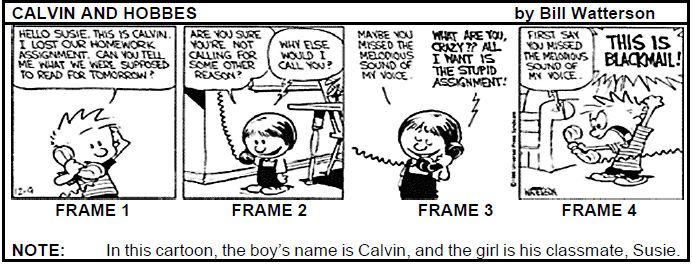
4.1 Refer to FRAME 1.
4.1.1 Why is Calvin phoning his classmate Susie? (1)
4.1.2 Choose the correct answer to complete the following sentence: Calvin is scratching his head because he is trying to…
- sing a song.
- help a friend.
- solve a problem.
- fix his hair. (1)
4.1.3 Provide an antonym for the word ‘lost’. (1)
4.2 Refer to FRAME 2.
4.2.1 Do you think Calvin phones Susie regularly? Explain. (1)
4.2.2 Write down the correct word for ‘call’. (1)
4.3 Refer to FRAMES 1 and 4.
4.3.1 Explain the difference between Calvin’s emotions in FRAME 1 and his emotions in FRAME 4 by referring to the verbal clues.(2)
4.3.2 Give a visual clue to show Calvin’s feelings in FRAME 4. (1)
4.4 Do you think Susie’s behaviour towards Calvin is justified? Substantiate your answer.(2)
[10]
QUESTION 5: LANGUAGE AND EDITING SKILLS
5.1 Read the passage (TEXT F) below, which has some deliberate errors, and answer the set questions.
TEXT F
JERUSALEMA
[Adapted from www.globalcitizen.org] |
5.1.1 Correct the SINGLE error in EACH of the following sentences. Write down ONLY the question numbers and the words you have corrected.
- In a year that has been both challenge and depleting, South Africans have managed to come out dancing. (1)
- This is all thanks to music producer Master KG and his internasional hit, Jerusalema. (1)
- Everyone from fireman in Romania to wildlife conservationists in Zimbabwe took part in the dance craze. (1)
- Jerusalema managed to uplift people all through the world and encouraged them to find a reason to celebrate life. (1)
5.1.2 Rewrite the following sentence in the simple past tense: Master KG wins the MTV Europe Music Award for Best African Act. (1)
5.1.3 Write the underlined symbol as a word. The dance challenge helped more than 56% of adults to reduce their emotional stress.(1)
5.1.4 Rewrite the following sentence in the negative form: The Jerusalema dance challenge boosts feelings of happiness. (1)
5.1.5 Give the plural form of the underlined word in the following sentence: The Jerusalema dance had a positive impact on life. (1)
5.1.6 Rewrite the following sentence in reported speech: Master KG said, ‘My Jerusalema song has earned millions of views on YouTube.’ (3)
5.1.7 Combine the following sentences into a single sentence:
The Jerusalema is a source of brightness.
The Jerusalema is a source of hope.
Begin with the following words: Not only … (2)
5.1.8 Study the following sentence: South Africans rose to the challenge and soon enough the entire country was dancing to Jerusalema. (1)
Use a homonym for the word rose in a sentence of your own.
5.2 Study the text below and answer the questions.
TEXT G
‘Veldskoen’ or ‘vellies’, are South African walking shoes. The name ‘vellies’ comes from the Afrikaans words ‘vel’ which means skin and ‘skoen’ which means shoe. [Source: www.Hellosmartblog.com] |
5.2.1 Rewrite the following sentence in the passive voice: Both men and women can wear vellies. (1)
5.2.2 Complete the following tag question. Write down only the missing words. Vellies are South African walking shoes, …? (1)
5.2.3 Study the following sentence: Nowadays you can wear your vellies with a gorgeous floral dress or a soft flowy skirt. State the part of speech of EACH of the underlined words used in the context of this sentence. (2)
5.2.4 Give the correct form of the word in brackets. The genuine leather veldskoen is crafted with much (patient). (1)
5.2.5 Give the correct degree of comparison in the following sentence: Vellies are the (comfortable) shoes to wear when visiting the bush. (1)
[20]
TOTAL SECTION C: 40
GRAND TOTAL: 80
Electrical Technology: Electronics Memorandum - Grade 12 September 2021 Preparatory Exams
INSTRUCTIONS TO MARKERS
- All questions with multiple answers imply that any relevant, acceptable answer should be considered.
- Calculations:
2.1 All calculations must show the formulae.
2.2 Substitution of values must be done correctly.
2.3 All answers MUST contain the correct unit to be considered.
2.4 Alternative methods must be considered, provided that the correct answer is obtained.
2.5 Where an incorrect answer could be carried over to the next step, the first answer will be deemed incorrect. However, should the incorrect answer be carried over correctly, the marker has to re- calculate the values, using the incorrect answer from the first calculation. If correctly used, the candidate should receive the full marks for subsequent calculations.
2.6 Markers should consider that candidates' answers may deviate slightly from the marking a guideline depending on how and where in the calculation rounding off was used. - These marking guidelines are only a guide with model answers.
- Alternative interpretations must be considered and marked on merit. However, this principle should be applied consistently throughout the marking session at ALL marking centres.
MEMORANDUM
QUESTION 1: MULTIPLE CHOICE QUESTIONS
1.1
1.1 B (1)
1.2 A (1)
1.3 D (1)
1.4 C (1)
1.5 C (1)
1.6 A (1)
1.7 D (1)
1.8 A (1)
1.9 C (1)
1.10 D (1)
1.11 D (1)
1.12 A (1)
1.13 B (1)
1.14 D (1)
1.15 B (1) [15]
QUESTION 2: OCCUPATIONAL HEALTH AND SAFETY
2.1
2.1.1 The probability that injury or damage will occur. (1)
2.1.2 Free from any hazard. (1)
2.2
- In quantitative risk analysis, an attempt is made to numerically determine the probabilities of various adverse events and the likely extent of losses if a particular event took place.
- Qualitative risk analysis defines the various threats determining the extent of vulnerabilities and devising counter measures should a risk occur. (5)
2.3
- Use or misuse of power tools.
- Incorrect use and handling of hand tools.
- Etching of printed circuit boards. (Any 1 x 1) (1)
2.4 Inadequate lighting leads to poor visibility, which could lead to dangerous situations or injuries. (2)
[10]
QUESTION 3: RLC CIRCUITS
3.1 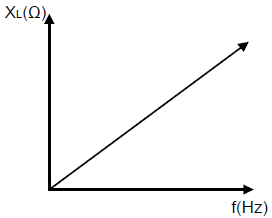
1 mark for correct labelling of axes
1 mark for correct shape of curve (2)
3.2 The capacitive reactance is inversely proportional to the frequency. (1)
3.3 It is the shift in phase between the supply voltage and the circuit current which results from the reactance and resistance in the circuit. (2)
3.4
3.4.1 The current lags the voltage. (1)
3.4.2  (3)
(3)
3.4.3 This occurs during resonance, when the voltage drop across the capacitor is equal to the voltage drop across the inductor. (2)
3.5 Used to tune radio and tv stations to a particular station. (1)
3.6
- In series current is maximum and in parallel current is zero.
- In series impedance is minimum and in parallel impedance is maximum. (2)
3.7
3.7.1
- X? = 2?ƒ?
= 2 × ? × 50 × 50 × 10−3
= 15,71 Ω (3)
3.7.2  (3)
(3)
3.7.3
- XC = 1
2πfC
C = 1
2πfX?
= 1
2×π×50×42,44
= 7,5 × 10−5F
= 75 µF (4)
3.8
3.8.1
- XC = 1
2πfC
= 1
2×π×25×100×10−6
= 63,66 Ω - IC = V
X?
= 100
63,66
= 1,57 A (5)
3.8.2  (3)
(3)
3.8.3 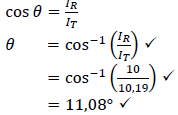 (3)
(3)
[35]
QUESTION 4: SEMICONDUCTOR DEVICES
4.1
- P-channel JFET or PFET
- N-channel JFET or NFET (2)
4.2
- Cut off region
- Negative resistance region
- Saturation region (3)
4.3 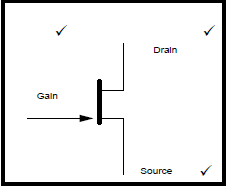 (3)
(3)
4.4
4.4.1 The emitter is a heavily doped p-type semi-conductor. (2)
4.4.2 The intrinsic standoff ratio is determined by the ratio of the internal resistances (rb1 to rb1 + rb2). (2)
4.4.3 The moment the emitter voltage (VE) is increased to above Vx the UJT is said to fire and goes into its trigger state. (2)
4.5 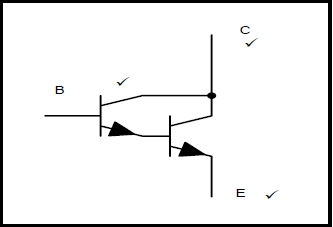 (3)
(3)
4.6
- The most important advantage of the Darlington pair as detailed above is its high current gain. This is decided by the gain of each individual transistor.
- Circuits improved input impedance ,this can be shown to be substantially increased making it far less likely to load any preceding stage of the circuit and so demand far less current to operate.
- When used in the common collector form the Darlington pair also develops very low output impedance. (4)
4.7
4.7.1
- 1 – non-inverting
- 2 – inverting (2)
4.7.2 It is important for the Op-amp to have a dual voltage supply to be able to amplify all signals above 0 V and below 0 V (positive and negative signals). (2)
4.8
- Differential Amplifier
- High Gain Differential Amplifier
- Common Collector (3)
4.9 Positive Supply (+V) (1)
4.10 The op-amp should be able to amplify any input of any frequency, from 0 Hz through to radio frequency and higher. This is not practical and the gain drops at higher frequencies. This is due to internal capacitances in the op-amp’s chip. (4)
4.11
- Very high input impedance
- Very low output impedance (2)
4.12 This pin is used to allow a different charge voltage level to be introduced to the 555 timer rather than the usual 2/3 point. This pin is normally either not connected or else it is connected to ground via a small value capacitor which removes any unwanted noise from the supply voltage that might affect the timer operation. (4)
4.13 This capacitor will remove any unwanted noise from the supply voltage which could affect the operation of the timer. (2)
4.14
- Two comparators
- S/R flip-flop (2)
4.15
- Monostable
- Astable
- Bistable (Any 2 x 1) (2)
[45]
QUESTION 5: SWITCHING CIRCUITS
5.1
5.1.1 Bistable multivibrator (1)
5.1.2 It protects the LED from drawing to much current and getting damaged. (1)
5.1.3 When RESET is pressed, Pin 4 is pulled to ground. This resets the IC and cause it to change state with the output falling to LOW. (3)
5.1.4 The low value capacitor (0,1µF) is used to remove any unwanted and stray signal from the circuit. The will prevent noise in the circuit. (3)
5.1.5
- The two inputs would be floating between +V and 0 V.
- When the SET or RESET button is pushed it would short circuit the supply to ground. (2)
5.2 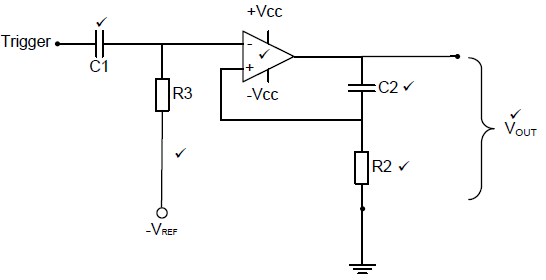 (6)
(6)
5.3
- Change the value of the timing capacitor.
- Change the value of the timing resistor.
- Change the values of both the timing capacitor and the timing resistor. (3)
5.4 Switch bounce can be eliminated by using a monostable multivibrator circuit to control the output. (1)
5.5 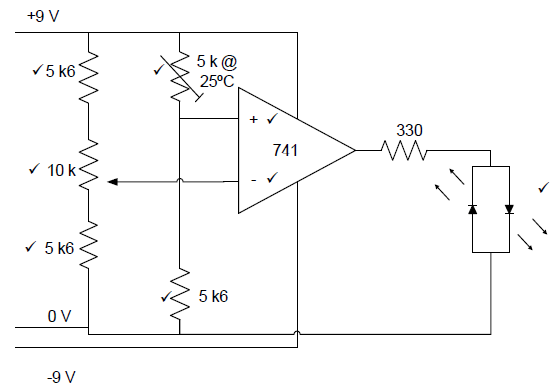 (8)
(8)
5.6
- The less light on the LDR, the higher the resistance.
- The more light on the LDR, the lower the resistance. (4)
5.7
5.7.1 Open loop gain refers to a circuit with no feedback from the output back to the input. (2)
5.7.2
- Voltage divider resistors R1 and R2 set up the reference voltage VREF.
- The reference voltage is fed back to the non-inverting input of the op-amp.
- The comparator compares the input voltage VIN to the reference voltage VREF.
- The gain of the op-amp is ±100 000 because of the open loop connection.
- Whenever there is a fraction of a millivolt difference between VIN and VREF, this difference will be amplified.
- The op-amp will be driven into either one of the saturation states. (6)
5.8
5.8.1 By adding another input resistor to the summing amplifier input. (1)
5.8.2 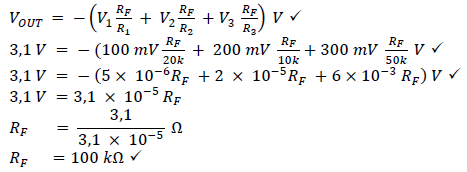 (4)
(4)
5.8.3 It is negative because the inputs are fed into the inverting input, which will cause the output to be 180° out of phase. (1)
5.9 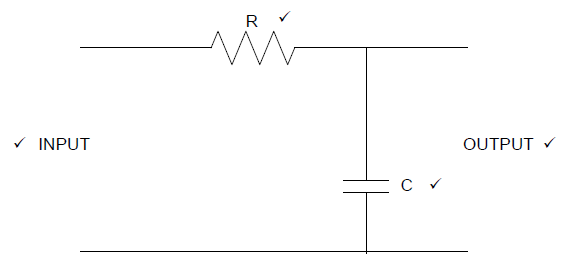 (4)
(4)
[50]
QUESTION 6: AMPLIFIERS
6.1
6.1.1
- To set the operating conditions (points) of the transistor.
- To stabilise the operating point of the transistor. (2)
6.1.2 Q-point on the DC load line represents the voltages across the transistor. and current through the transistor when no input signal is applied. (2)
6.1.3 Vce = Vcc (1)
6.1.4
- ?? = ???
??
= 9 ?
800 Ω
= 11,25 ? (3)
6.1.5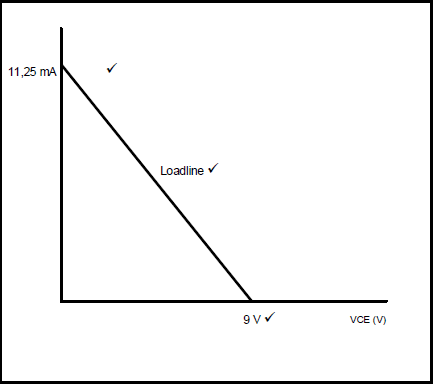 (3)
(3)
6.2
- ?1 = 20 ??? ????
?i?
= 20 ???10 15,3×10−3
3,6×10−3
?? = 12,57 ?? (3)
6.3
- Improving the amplifiers stability.
- Increase the amplifiers bandwidth.
- Enhancing the amplifiers input and output impedances
- Reducing or suppressing a noise produced within the amplifier. (Any 2 x 1) (2)
6.4
6.4.1
- When an AC voltage is applied to the input of the first amplifier stage, an alternating current will flow in the collector circuit of transistor.
- An alternating voltage will develop across the collector resistor (RC1). The developed alternating voltage across the RC1 will be transferred through capacitor C2 to the base of the transistor (Q2) in the amplifier’s second stage (stage 2).
- The process will be repeated and the amplified output will measured between C3 and 0 V. (6)
6.4.2
- Cheap, economical and compact as it uses only resistors and capacitors.
- Offers a constant gain over a wide frequency band. (2)
6.5
6.5.1
- A – Low frequency range
- B – Bandwidth
- C – High frequency range (3)
6.5.2 At the higher frequency as the signal frequency rises it encounters small parasitic capacitances which develop inside of the transistors. These capacitances appear between the different regions of the transistor due to their different biasing voltages as the signal frequency rises. The effect of these capacitor increases, with their reactance become lower and lower. (3)
6.6
6.6.1
- Transformer coupled amplifiers are made from coils of copper wire.
- The transformer winding resistance is very low.
- When used as the collector load in a transistor amplifier this creates a very high current with a small voltage output.
- This is useful for driving low impedance loads such as relays, loudspeakers and motors. (5)
6.6.2
- Excellent impedance matching can be achieved.
- Total DC isolation between stages. (2)
6.7
6.7.1
- When the DC base voltage drops to zero, transistors are OFF.
- The input signal must pass through the region where both transistors are not conducting. (2)
6.7.2  (6)
(6)
[45]
TOTAL: 200
Electrical Technology: Electronics Questions - Grade 12 September 2021 Preparatory Exams
INSTRUCTIONS AND INFORMATION
- This question paper consists of SIX questions.
- Sketches and diagrams must be large, neat and FULLY LABELLED.
- Show ALL calculations and round off answers to TWO decimal places.
- Number the answers correctly according to the numbering system used in this question paper.
- You may use a non-programmable calculator.
- Show the units for ALL answers of calculations.
- A formula sheet is attached at the end of this question paper.
- Write neatly and legibly.
QUESTIONS
QUESTION 1: MULTIPLE CHOICE QUESTIONS
Various options are provided as possible answer to the following questions. Choose the answer and write only the letter (A–D) next to the question numbers (1.1 to 1.15) in the ANSWER BOOK, for example 1.16 A.
1.1 To prevent infection when treating burns, the following should NOT be done:
- Do not take a pain killer
- Do not pop blisters
- Do not use a sterile gauze or bandage
- Do not hold the burned area under cool running water (1)
1.2 In a purely capacitive circuit, the relationship between the voltage and current is as follows:
- The current leads the voltage
- The current lags the voltage
- The current and voltage are in phase
- The current is zero (1)
1.3 During resonance the …
- inductive reactance is greater than capacitive reactance.
- capacitive reactance is greater than inductive reactance.
- impedance is equal to 1.
- inductive reactance is equal to capacitive reactance. (1)
1.4 In a 240 V, 50 Hz RCL circuit with an inductance of 50 mH, the inductive reactance is equal to …
- 151,7 Ω.
- 151,7 H.
- 15,71 Ω.
- 15,71 H. (1)
1.5 Which TWO characteristics are of interest in a JFET?
- Transfer and output
- UJT and output
- N-channel and transfer
- Darlington pair and metal oxide silicon field effect transistor (1)
1.6 Which device relies on the creation of an electric field within its body to control current flow?
- Field effect transistor
- Amplifier
- Gain
- 555 timers (1)
1.7 The maximum current a 555 IC can either sink or source is:
- 2 A
- 200 A
- 2 m A
- 20 m A (1)
1.8 With reference to a monostable multivibrator, the time an output stays high, is determined by:
- The time constant (RC)
- The length of time you push the button
- The magnitude of the supply voltage
- It will stay high indefinitely (1)
1.9 The Bistable multivibrator has the following characteristics:
- Free running with ONE input
- Free running with TWO inputs
- TWO stable states with TWO inputs
- NO stable states with ONE input (1)
1.10 A Light Dependant Resistor (LDR) will change value due to:
- Wind blowing on the LDR
- Current flowing through the LDR
- A voltage drop across the LDR
- The change of light shining on the LDR (1)
1.11 The output waveform of a Schmitt trigger circuit will always be a:
- Sine wave
- Triangular wave
- Radio wave
- Square wave (1)
1.12 Which ONE is the application of a RC coupled amplifier?
- Radio or TV receivers
- Most use in impedance matching
- Used as a driver amplifiers
- Output amplifiers (1)
1.13 A disadvantage of a RC coupled amplifier is …
- RF communication.
- that it is unsuitable for low frequency amplification.
- optical fibre communications.
- offers a constant gain over a wide frequency band. (1)
1.1.4 The … of an amplifier is the range of frequencies within which the gain does not fall below 0,7 of its maximum value.
- complimentary push pull
- transistor
- bandwidth
- radio frequency amplifier (1)
1.15 Which ONE is an important area on the frequency response curve?
- Impedance matching
- Low frequency cut off region
- Negative feedback
- De isolation (1)
[15]
QUESTION 2: OCCUPATIONAL HEALTH AND SAFETY
2.1 Give the meaning of the following with reference to the Occupational Health and Safety, 1993 (Act 85 of 1993).
2.1.1 Risk (1)
2.1.2 Safe (1)
2.2 Explain the difference between quantitative risk analysis and qualitative risk analysis. (5)
2.3 State ONE example of a dangerous practice in an electrical workshop. (1)
2.4 Explain how inadequate lighting is an unsafe condition. (2)
[10]
QUESTION 3: RLC CIRCUITS
3.1 Draw a neat, labelled characteristic curve showing the relationship between the inductive reactance and the frequency in a pure inductive circuit. (2)
3.2 State the relationship between the capacitive reactance and the frequency in a pure capacitive circuit. (1)
3.3 Define the term phase angle with reference to RLC circuits. (2)
3.4 FIGURE 3.4 below shows the phasor diagram of the voltages and current in a series circuit. Answer the questions that follow.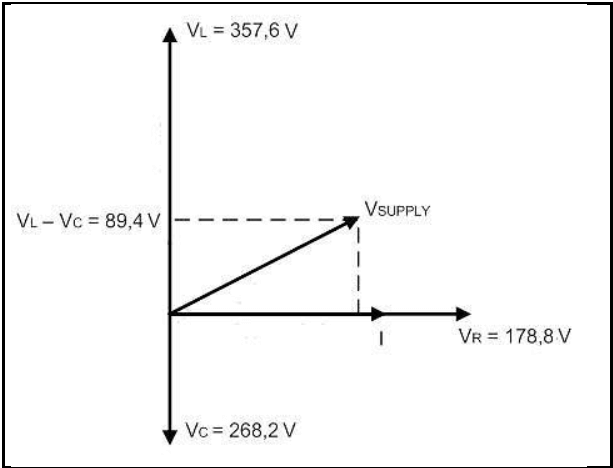
FIGURE 3.4
3.4.1 State with reference to the current, whether the phase angle is leading or lagging. (1)
3.4.2 Calculate the value of the supply voltage. (3)
3.4.3 Explain when the current would be in phase with the voltage of the circuit. (2)
3.5 State where resonant circuits are used. (1)
3.6 Describe the differences between the characteristics of series and parallel resonance. (2)
3.7 The series RLC circuit in FIGURE 3.7 consists of a 22 Ω resistor, an inductor of 50 mH and a capacitor with a reactance of 42,44 Ω. The series combination is connected to a 110 V/50 Hz supply. Answer the questions that follow.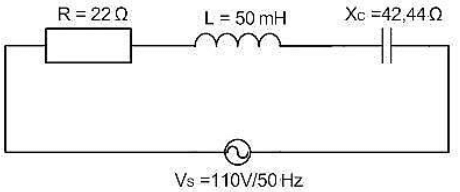
FIGURE 3.7
Given:
- R = 22 Ω
- L = 50 Mh
- X? = 42,44 Ω
- VS = 110 V
- f = 50 Hz
Calculate:
3.7.1 The inductive reactance (3)
3.7.2 The impedance of the circuit (3)
3.7.3 The value of the capacitor in the circuit in micro-farad (4)
3.8 Refer to FIGURE 3.8 below and answer the questions that follow.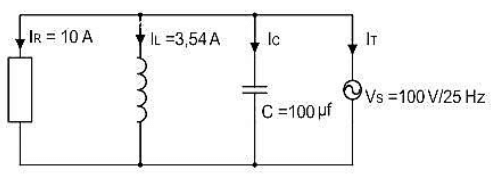
FIGURE 3.8
Given:
- IR = 10 A
- IL = 3,54 A
- C = 100 µF
- VS = 100 V
- f = 25 Hz
Calculate:
3.8.1 The current flowing through the capacitor (5)
3.8.2 The total current flowing through the circuit (3)
3.8.3 The phase angle (3)
[35]
QUESTION 4: SEMICONDUCTOR DEVICES
4.1 Name TWO types of junction field effect transistors. (2)
4.2 List THREE operating regions of the UJT. (3)
4.3 Draw a fully labelled symbol of the N-channel JFET. (3)
4.4 Refer to FIGURE 4.4 below and answer the questions that follow.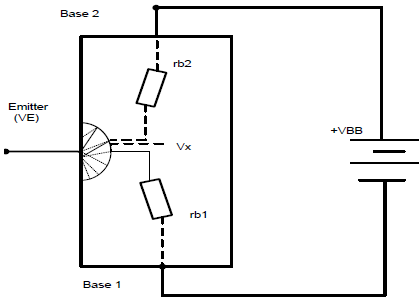
FIGURE 4.4: UJT
4.4.1 State the type of material used to produce the substrate. (2)
4.4.2 Explain how the intrinsic standoff ratio is determined. (2)
4.4.3 Explain what happens when the voltage on the emitter terminal (VE) is increased above Vx. (2)
4.5 Draw a fully labelled symbol of a Darlington pair transistor. (3)
4.6 Describe TWO advantages of a Darlington pair. (4)
4.7 Refer to FIGURE 4.7 and answer the questions that follow.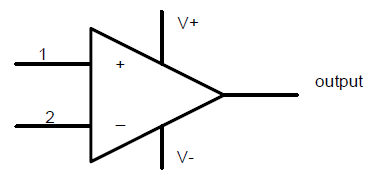
FIGURE 4.7: OP-AMP SYMBOL
4.7.1 Label number 1 and 2. (2)
4.7.2 Explain why the op-amp uses a dual voltage supply. (2)
4.8 Name the THREE stages of an op-amp. (3)
4.9 Identify Pin 7 of a 741 op-amp. (1)
4.10 With reference to op-amp characteristics, explain the term bandwidth. (4)
4.11 Explain why an op-amp as a voltage follower is an ideal coupling stage (buffer) between two unevenly matched stages. (2)
4.12 With reference to 555 IC, explain the function of pin 5 (control voltage). (4)
4.13 Explain the function of using a small value capacitor connected from pin 5 to ground on a 555 IC. (2)
4.14 Name the TWO primary building blocks of a 555 IC. (2)
4.15 Name TWO modes the 555 IC is set up to function in. (2)
[45]
QUESTION 5: SWITCHING CIRCUITS
5.1 With reference to FIGURE 5.1 below, answer the following questions.
FIGURE 5.1: MULTIVIBRATOR
5.1.1 Identify the circuit in FIGURE 5.1 above. (1)
5.1.2 State the function of R3. (1)
5.1.3 Describe what happens when the RESET switch, S2 is pressed. (3)
5.1.4 Explain the purpose of C1 which is connected to ground from pin 5. (3)
5.1.5 Explain what the effect would be on the circuit if R1 and R2 were not added to the circuit. (2)
5.2 Draw a fully labelled circuit diagram for a monostable multivibrator op-amp circuit. (6)
5.3 Explain how you would vary the length of time that a monostable multivibrator circuit output stays ‘HIGH’. (3)
5.4 Explain how to eliminate switch bounce. (1)
5.5 Draw a fully labelled circuit diagram for a temperature sensor using a 741 op-amp. (8)
5.6 Explain the principle of operation of a Light Dependant Resistor (LDR). (4)
5.7 Refer to FIGURE 5.7 below and answer the questions that follow.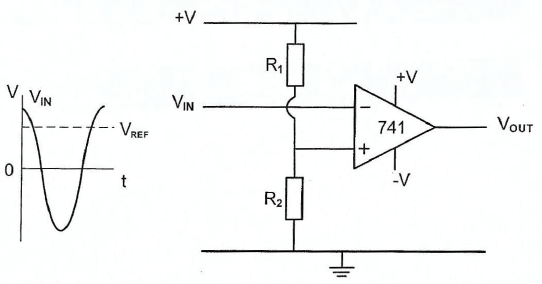
FIGURE 5.7: COMPARATOR
5.7.1 Explain what is meant with open loop with reference to FIGURE 5.7. (2)
5.7.2 Describe the principle of operation of a comparator. (6)
5.8 Refer to FIGURE 5.8 below and answer the questions that follow.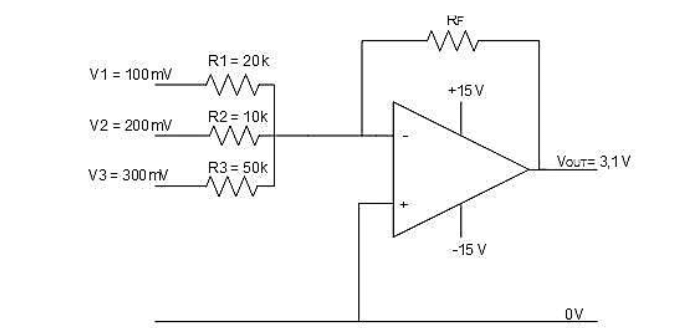
FIGURE 5.8: SUMMING AMPLIFIER
5.8.1 State how an input signal can be added to the summing amplifier. (1)
5.8.2 Calculate the value of the feedback resistor (RF). (4)
5.8.3 State why the output voltage is negative in FIGURE 5.8. (1)
5.9 Draw the circuit diagram for a passive integrator. (4)
[50]
QUESTION 6: AMPLIFIERS
6.1 Refer to FIGURE 6.1 below and answer the following questions.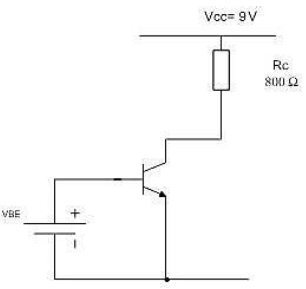
FIGURE 6.1
6.1.1 List TWO reasons for biasing a transistor. (2)
6.1.2 Describe the term Q-point on a DC load line. (2)
6.1.3 State the formula for Vce. (1)
6.1.4 Calculate the maximum collector current. (3)
6.1.5 Draw the DC load line and indicate the maximum current and Vce. (3)
6.2 Audio amplifiers terminal currents are measured as 3,6 mA input current and 15,3 mA output current. Calculate the amplifier current in decibels. (3)
6.3 Explain TWO advantages of negative feedback. (2)
6.4 Refer to FIGURE 6.4 below and answer the questions that follow.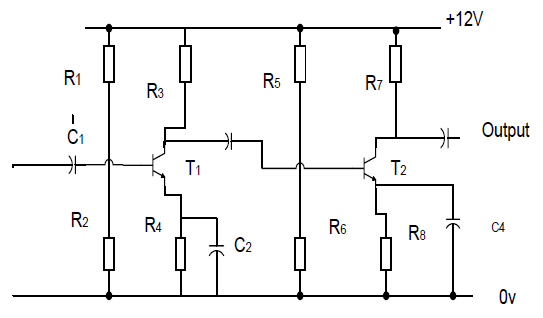
FIGURE 6.4: RC COUPLED AMPLIFIER
6.4.1 Describe the operation of a RC coupled amplifier. (6)
6.4.2 List TWO advantages of the RC coupled amplifier. (2)
6.5 FIGURE 6.5 below shows the frequency response curve of a RC coupled amplifier. Answer the questions that follow.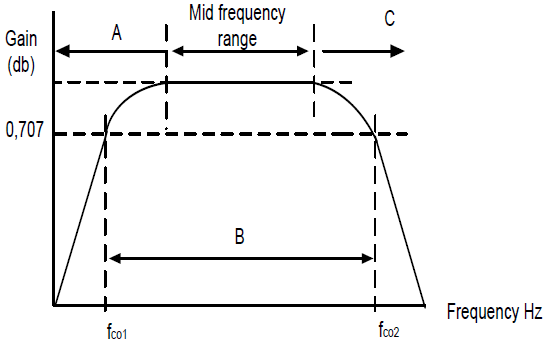
FIGURE 6.5: FREQUENCY RESPONSE CURVE OF A RC COUPLED AMPLIFIER.
6.5.1 Identify points A, B, and C. (3)
6.5.2 Describe how the voltage gain of an RC-coupled amplifier is affected at high frequencies. (3)
6.6 Refer to FIGURE 6.6 below and answer the questions that follow.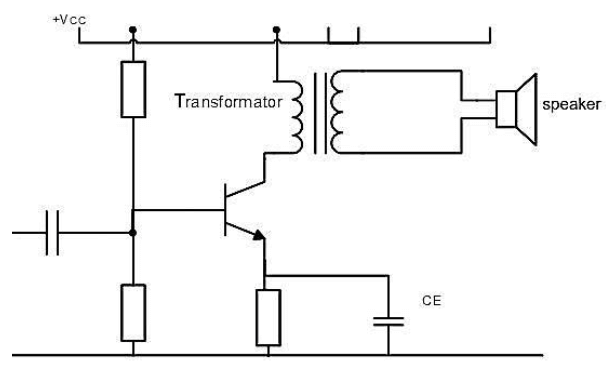
FIGURE 6.6: TRANSFORMER COUPLED AMPLIFIER
6.6.1 Describe the basic operation of the transformer coupled amplifier. (5)
6.6.2 State TWO advantages of a transformer coupled amplifier. (2)
6.7 With reference to a push-pull amplifier NPN transistor. Answer the questions that follow.
6.7.1 Explain how cross over distortion occurs. (2)
6.7.2 Calculate the current gain in dB by using the following information:
- Output power = 100 W
- Input power = 4 W
- Input voltage = 100 V
- Input current = 100 mA
- Output impedance = 20 Ω (6)
[45]
TOTAL: 200
FORMULA SHEET:
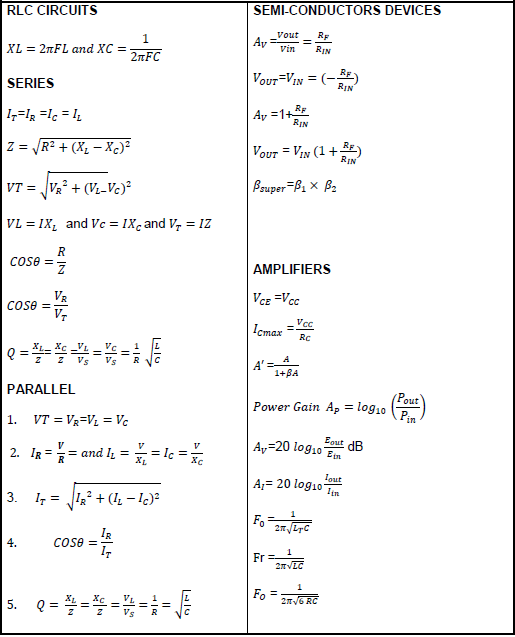
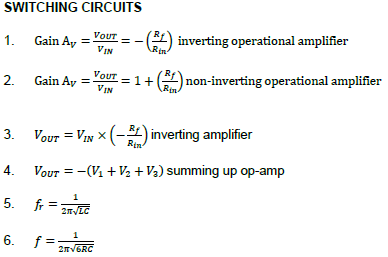
Electrical Technology: Power Systems Memorandum - Grade 12 September 2021 Preparatory Exams
INSTRUCTIONS TO MARKERS
- All questions with multiple answers imply that any relevant, acceptable answer should be considered.
- Calculations
2.1 All calculations must show the formulae.
2.2 Substitution of values must be done correctly.
2.3 All answers MUST contain the correct unit to be considered.
2.4 Alternative methods must be considered, provided that the correct answer is obtained.
2.5 Where an incorrect answer could be carried over to the next step, the first answer will be deemed incorrect. However, should the incorrect answer be carried over correctly, the marker has to re-calculate the values, using the incorrect answer from the first calculation. If correctly used, the candidate should receive the full marks for subsequent calculations.
2.6 Markers should consider that learners answers may deviate slightly from the marking guideline depending on how and where in the calculation rounding off was used. - These marking guidelines are only a guide with model answers.
- Alternative interpretations must be considered and marked on merit. However, this principle should be applied consistently throughout the marking session at ALL marking centres.
MEMORANDUM
QUESTION 1: MULTIPLE-CHOICE QUESTIONS
1.1
1.1 B (1)
1.2 A (1)
1.3 D (1)
1.4 C (1)
1.5 A (1)
1.6 C (1)
1.7 B (1)
1.8 A (1)
1.9 D (1)
1.10 C (1)
1.11 B (1)
1.12 D (1)
1.13 A (1)
1.14 C (1)
1.15 B (1) [15]
QUESTION 2: OCCUPATIONAL HEALTH AND SAFETY
2.1
2.1.1 The probability that injury or damage will occur. (1)
2.1.2 Free from any hazard. (1)
2.2 In quantitative risk analysis an attempt is made to numerically determine the probabilities of various adverse events and the likely extent of losses if a particular event took place. Qualitative risk analysis defines the various threats determining the extent of vulnerabilities and devising counter measures should a risk occur. (5)
2.3
- Use or misuse of power tools.
- Incorrect use and handling of hand tools.
- Etching of printed circuit boards. (Any 1 x 1) (1)
2.4 Inadequate lighting leads to poor visibility, which could lead to dangerous situations or injuries.(2)
[10]
QUESTION 3: RLC CIRCUITS
3.1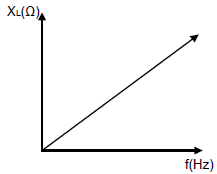
1 mark for correct labelling of axes
1 mark for correct shape of curve (2)
3.2 The capacitive reactance is inversely proportional to the frequency. (1)
3.3 It is the shift in phase between the supply voltage and the circuit current which results from the reactances and resistance in the circuit. (2)
3.4
3.4.1 The current lags the voltage. (1)
3.4.2 (3)
(3)
3.4.3 This occurs during resonance, when the voltage drop across the capacitor is equal to the voltage drop across the inductor. (2)
3.5 Used to tune radio and TV stations to a particular station. (1)
3.6
- In series, current is maximum and in parallel current is zero.
- In series, impedance is minimum and in parallel impedance is maximum. (2)
3.7
3.7.1
- X? = 2?ƒ?
= 2 × ? × 50 × 50 × 10−3
= 15,71 Ω (3)
3.7.2  (3)
(3)
3.7.3
- XC = 1
2?fC
C = 1
2?fC
= 1
2×?×50×42,44
= 7,5 × 10−5F
= 75 µF (4)
3.8
3.8.1
- XC = 1
2?fC
= 1
2×?×25×100×10−6
= 63,66 Ω
IC = V
X?
= 100
63,66
= 1,57 A (5)
3.8.2  (3)
(3)
3.8.3
- cos ? = ??
??
? = cos−1 (??)
??
= cos−1 ( 10 )
10,19
= 11,08° (3)
[35]
QUESTION 4: THREE-PHASE AC GENERATION
4.1
- Aluminium is lighter and a good conductor.
- Steel adds strength. (2)
4.2 Kilowatt-hour meter (1)
4.3
- More current is used
- Higher monthly electricity bill
- More heat generated by equipment resulting in shorter lifespan
- More maintenance of equipment required (3)
4.4
4.4.1 Three-phase star connected system phasor diagram (1)
4.4.2
- α – 30°
- β – 120° (2)
4.4.3 A – VRN (1)
4.4.4 By connecting the common ends of three phasors together. (1)
4.4.5
- VYB = √3VYN
= √3 × 219,395
= 380 V (3)
4.5
4.5.1
- VL = √3VPH
= √3 × 220
= 381,05 V (3)
4.5.2
- η = POUT × 100%
PIN
PIN = POUT×100
η
= 12 000×100
86
= 13 953,49 W = 13,95 kW (3)
4.5.3
- PIN = √3VLIL cos ?
IL = PIN
√3VL cos ?
= 13 953,49
√3×381,05×0,87
= 24,30 A (3)
4.6
4.6.1
- ? = √3VLIL cos ?
= √3 × 400 × 43,3 × cos 25
= 27 188,44 W = 27,19 kW
OR
P = S cos ?
= 30 000 × cos 25
= 27 189,32 W = 27,19 kW (3)
4.6.2
- Q = √3VLIL sin ?
= √3 × 400 × 43,3 × sin 25
= 12 678,18 VAr = 12,68 kVAr
OR
? = ? sin ?
= 30 000 × sin 25
= 12 678,55 ??? = 12,68 ???? (3)
4.6.3
- IPH = IL
√3
= 43,3
√3
= 25 A (3)
4.6.4
- Power factor = cos ?
= cos 25
= 0,91 (3)
[35]
QUESTION 5: THREE-PHASE TRANSFORMERS
5.1
5.1.1 A step-down transformer in high voltage lines. (1)
5.1.2 As step-down transformers in distribution systems where a 4-wire system is required. (1)
5.2
- The oil may be impure due to carbonisation.
- The oil may be insufficient. (2)
5.3
- The windings are enclosed.
- The coils are wound around the centre section of the core.
- The axis of the shell-type can be vertical or horizontal. (3)
5.4
- Winding failures
- Tap changing failures
- Bushing failures
- Terminal board failures
- Core failures (Any 2 x 1) (2)
5.5
5.5.1
- POUT = S cos ?
= 50 000 × 0,8
= 40 000 W = 40 kW (3)
5.5.2
- η = ?0?? × 100%
?0??+??????
= 40000 × 100
40 000+250+180
= 98,94% (3)
5.6
5.6.1
- VLP = VPP = 110 00V
VPS = VPP
44
= 11 000
44
= 250 V (4)
5.6.2
- VLS = √3VPS
= √3 × 250
= 433,01 V (3)
5.6.3
- ? = √3VLSILS cos ?
ILS = P
√3VLS cos ?
= 25 000
√3×433,01×41,67
= 41,67 A (3)
5.6.4
- ILS = IPS
= 41,67 A (2)
5.6.5
- S = √3VLSILS
= √3 × 433,091 × 41,67
= 31 252, VA = 31,25 kVA
OR - ? = P
cos ?
= 25 000
0,8
= 1 250 VA = 1,25 kVA (3)
[30]
QUESTION 6: THREE-PHASE MOTORS AND STARTERS
6.1
6.1.1
- A – stator losses
- B – windage and friction losses (2)
6.1.2
- Terminal box
- Cooling fan
- End plates
- Yoke (frame)
- Bearings (Any 3 x 1) (3)
6.2 Slip (1)
6.3 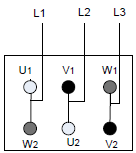
1 mark for each correct connection (3)
6.4
- When the start button is pressed, the main contactor (MC1) is energised. This changes the state of all MC1 contacts and the timer (T1) and the star contactor (MC2) are energised.
- The motor runs in star while the timer is timing and the delta contactor (MC3) is prevented from being energised.
- After the preset time, the timer de-energises the star contactor and energises the delta contactor.
- The motor runs in delta until the stop button is pressed. (6)
6.5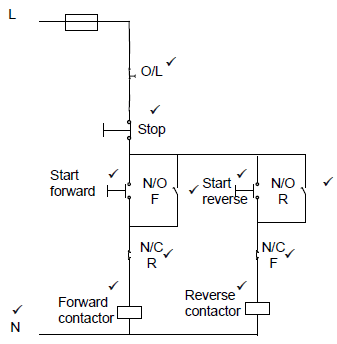
Symbol plus label = 1 mark
1 mark for connecting to neutral (11)
6.6
6.6.1
- ? = NS − NR
= 1 500 − 1 440
= 60 rpm (3)
6.6.2
- NS = f60
p
f = NSp
60
= 50 Hz (3)
6.6.3
- POUT = √3VLSILS cos ?
IL = POUT
√3VL cos ?
= 5 000
√3×380×0,85
= 8,94 A (3)
[35]
QUESTION 7: PROGRAMMABLE LOGIC CONTROLLERS (PLC’s)
7.1
7.1.1 When a device or socket has been wired up through a permanent, fixed circuit. (1)
7.1.2 The time the PLC takes to go through one complete cycle, processing each of the three steps.
7.2 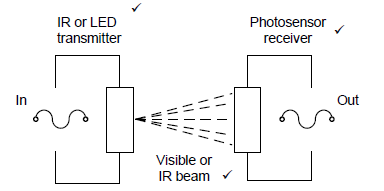
1 mark for in and out
1 mark for diagram correct (5)
7.3
7.3.1 
1 mark for symbol
1 mark for labels (2)
7.3.2
- a – 1
- b – 1
- c – 1 (3)
7.3.3  (3)
(3)
7.4
7.4.1
- Pushbutton switches
- Limit switches
- Proximity sensors
- Light sensors
- Temperature sensors (Any 2 x 1) (2)
7.4.2
- Relays
- Contactors
- Timers
- Lamps (Any 2 x 1) (2)
7.5
7.5.1 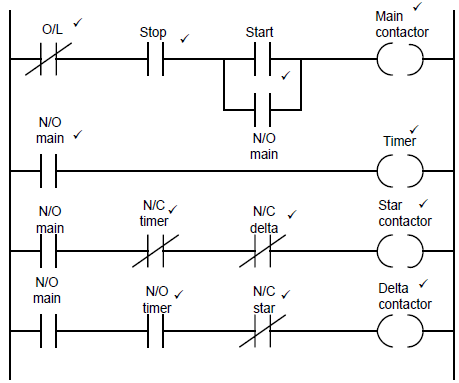 (12)
(12)
7.5.2 These are interlocking contacts, and they prevent one contactor from being energised while the other contactor is energised. (2)
7.5.3 The N/O main contact connected in parallel with the start button keeps the circuit energised (latching contact). (2)
7.5.4 The timer keeps the motor running in star for a preset time before energising the delta contactor. (1)
7.6
1 mark for each symbol and label correct (3)
[40]
TOTAL: 200
